The Battle of the Little Bighorn
A Most Merry and Illustrated History and Interactive (Sort of) Account with Merry Mini-Reviews of the Sources and References Thrown In
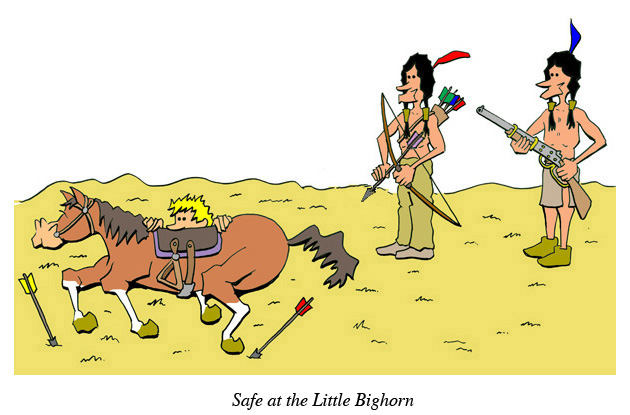
A Most Merry and Illustrated History and Interactive (Sort of) Account with Merry Mini-Reviews of the Sources and References Thrown In

On May 8, 1876, General of the Army, William Tecumseh Sherman, picked up his pen and wrote a short note to Brigadier General Alfred H. Terry. Alfred, like most army officers of the time, was a Civil War veteran, but now he was the military commander of the Dakota Territory. At that time "Dakota" meant not only the modern states of North and South Dakota but also included Minnesota and Montana as well. So Alfred had a lot of territory to cover.
What Sherman was writing about, though, was one Alfred's subordinates, Lieutenant Colonel George Armstrong Custer. George had been slated to lead an expedition to find some Indians who were wandering around the territory and get them back on the reservation. Every spring the Indians got tired of starving on moldy government rations and headed out onto the plains. The only trouble was the government said they weren't supposed to do that.
But while George and everyone else was getting ready to go, one of the Democratic senators from Pennsylvania, Hiester C. Clymer, had started up a committee investigating corruption in the army. He invited George to come in and testify if he had seen any shenanigans. George, a loyal public servant, was most happy to oblige.
During his testimony, George had said that he thought that President Grant's Secretary of War, William Belknap, was taking bribes. Oh, he had no specific reason for thinking this, George admitted. But the last time George had seen William, the secretary was rather curt and brusque in his manner. Oh, yes, Orvil, the brother of President Grant, was probably in the shady dealings, too. Hiester thanked George for his valuable information, and George got ready to head back and get ready for his expedition.
Unfortunately, President Grant didn't like political opponents like Hiester or piddly-ant lieutenant colonels like George saying his cabinet members were crooks, let alone his brother. So Grant wrote to Sherman that George could forget about going on any expedition.
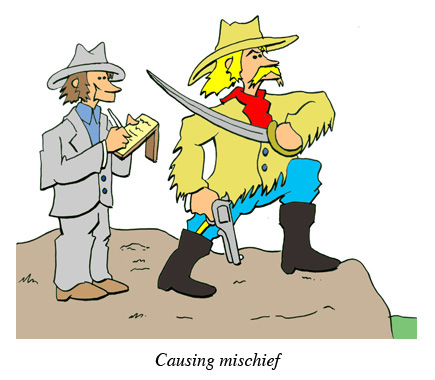
Now it was George's turn to be upset. Good grief, all he had done was cooperate with a government investigation. He had sworn to tell the truth and he had done so to the best of his ability. Why was he being singled out?
There was only one thing to do. George wrote (for him) a humble letter to Grant. Surely a fellow soldier like the President knew the humiliation it would be for a commander to remain behind while his men went into battle. Alfred then added his own note that although he didn't want to oppose the wishes of the President, nevertheless it would be very helpful if George went along. Phillip Sheridan, the famous Civil War cavalry officer and now Alfred's boss, also added a note giving (lukewarm) support for Custer. All letters were passed through channels and on up to the President. Finally Grant said, all right. If Alfred wanted George to go along, George could go along.
Soon Sherman was writing back to Alfred to pass along the good news. But, he warned, George had better be a good boy. He should stick strictly to business and avoid publicity. And for heaven's sake, tell George not to take along any newspaper reporters. They caused nothing but mischief.
Whether it because one of the men killed with George at the Battle of the Little Bighorn was Mark W. Kellogg, a reporter for the Bismarck Tribune or for some other reason, one of the first editorial assessments of the Battle of the Little Bighorn was from the President of the United States himself. George, he said, and George alone was to blame for the whole sorry mess.
Off the Reservation

Ever since June 25, 1876 some people have agreed with President Grant, others haven't. Even today one of the hottest debates among historians is about George. Was he one of the biggest jerks in the history of the army, a petty, small minded martinet whose arrogance and political ambitions pushed him into one of the worst military blunders ever? Or was he the best field commander of the Indian Wars ever produced and whose bold and decisive action was thwarted by incompetent subordinates who even went so far as to deliberately abandon him and his command to utter annihilation? Of course, since after more than a century we're still getting these spittle flinging diatribes (often courteously couched in endowed-chair academic debates), about all we can say is no one really knows the answer.
That spittle flinging diatribe concluded, pretty much everybody does know the general (no pun intended) cause of the battle. The Battle of the Little Bighorn occurred because the United States had never quite figured out what to do with the American Indian. After all, just what the heck do you do with all those Native Americans whose tribes 1) the United States government decided to treat as independent nations, 2) expected to be treated as independent nations, and 3) were occupying lands that the white settlers wanted and that the government - due to its "Manifest Destiny" - fully intended to get its hands on?
To make a long and complex story short and simple, the Indians were told to stay on the reservations. There they could draw their monthly rations, and if they wanted to try farming, that was fine, too. In any case they could not wander outside their designated tribal lands.
The government, though, wasn't keeping their end of the bargain. George was right in one sense. The Bureau of Indian Affairs was fraught with corruption, and Indian agents were lining their pockets and stealing the tribes blind. With only paltry government issues coming in, it was only logical that the Indians would ride out onto the plains and hunt buffalo. Although the massive herds had been rapidly depleted beginning in the mid-1860's, it was a better living than waiting around to be cheated by corrupt officials and tradesmen. Besides, tribal governments of the plains Indians were not organized like that of the United States government. If individuals didn't like an agreement made by a tribal elder, they saw no reason to abide by it. Besides, they liked living on the plains as their ancestors had.
By the end of 1875, the US government had issued an ultimatum. All Indians not on the reservations had to return by January 31 or be declared "hostile". They would then fall under the jurisdiction of the Department of War, not the Department of the Interior. Still by springtime as many as half the residents of the reservations had loaded up their horses and were out on the plains. That's where George, Alfred, and the rest came in.
George and the Rest

"The rest" was quite an assortment. It included not only George's fellow officers and ordinary soldiers, but the wives, relatives, and various hangers on. Everyone was stationed at Fort Abraham Lincoln which is now a nice state park in North Dakota a few miles south of present day Bismarck. The big cheese, by the way, at Fort Lincoln was not George, but full Colonel Samuel D. Sturgis. But Sam was away on a temporary assignment, and so George was in charge.
With Sam away, the third in command became the second in command. That was Major Marcus A. Reno. Like George, Marcus was a Civil War veteran who had been "brevetted" to a general's rank. But like virtually all officers, he was knocked back to his "permanent" rank (which was a captain) once the war was over. But by 1868 he had made it back to a major, which wasn't a bad rise for a peacetime soldier. As a bachelor (widower, actually) at a fort where most of the ladies were spoken for, Marcus didn't have much to do but smoke, drink and play high-stakes billiards.
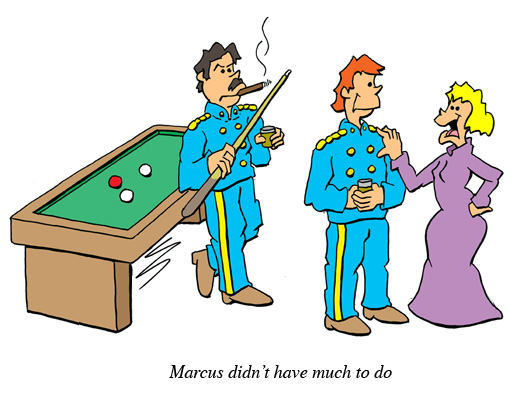
Then there was Frederick W. Benteen, looking a bit older than his years due to his craggy features and thick grey hair. Frederick had risen to the rank of colonel in the Civil War, but after Appomattox he had also been knocked back to his regular rank which was in Frederick's case was a captain.
For historians, Frederick has been kind of hard to figure out. Militarily he is inevitably rated high, and his cranky, curmudgeonly character seems to have been mostly directed at his superiors. Men who served under him were impressed by both his courage and his smooth way of dealing with his subordinates. But generally if you like George, you don't care for Frederick.
Frederick wrote quite a bit about his former commander, both in private letters and for public consumption. At times he seems to have wandered a bit outside the bounds of good taste. George had a somewhat halting manner of speech (his childhood nickname "Autie" had arisen from his inability to pronounced "Armstrong"), and this was an (admittedly irrelevant) trait that Frederick thought important enough to tell everyone about. So when he wrote about George he'd sometimes add comments like "Custer stammered slightly and said ... With a slight stammer General Custer said ... ", stuff like that. So clearly his relationship with George was - to use Frederick's own words - "not of the warmest personal nature."
To put it in no-nonsense plain spoken language, Frederick hated George's guts. The reasons were varied and were both specific and general. The most specific reason is that Frederick believed George had abandoned one of his officers to be killed. On November 27, 1868, George led an attack on an Indian village of about fifty families along the Washita River in present day Oklahoma. Like at the Little Bighorn, the goal was to get the Indians back on the reservations. Ironically, the chief, Black Kettle had tried to surrender earlier, but was told to go back to his village and wait. So now it was George's job to bring the Indians back to the fort.
You'd think that all George would have had to do was ride to Black Kettle and tell him to come on in. But political pressures had dictated more decisive action. Indians had also been raiding farms and ranches, and some settlers had been killed. Whether these raiding parties originated from Black Kettle's village is debated, but it really was irrelevant. Plains Indian "chiefs" had no executive authority. If they made any agreement, anyone who wanted to ignore them could. But such a division in authority wasn't understood by most Americans who lumped all the Indians together. To handle the problem, General Sheridan, at the time George's boss, issued instructions to "kill or hang all warriors" and bring the women and children - the "non-combatants"- in to the fort.
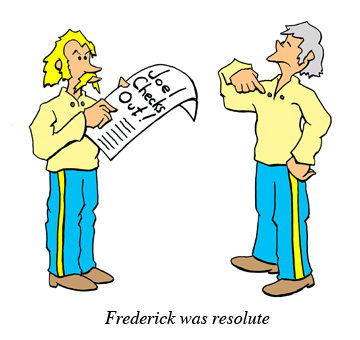
George's strategy, then, was simple. Ride into the village, kill (or hang) all the warriors, and if any women and children survive, take them prisoner. Next destroy the Indian's possessions, food, and shoot all 900 of their horses except those needed to carry the prisoners through the snow back to the fort. Any warriors who wanted to see their wives and children again would have to turn themselves in. We should mention here that is the way it really was done and was not just an invention of bleeding heart Hollywood scriptwriters.
That's what happened. At dawn the soldiers swept into the village and shot any warriors they saw. After rounding up the women and children (a number of whom had been killed), George burned the village, killed the horses, and went back to Camp Supply.
But when the fight was over not all the soldiers were accounted for. During the attack, one of the columns had been led by Major Joel Elliott. After the first onslaught, Joel and about fifteen other men had taken off after a band of warriors who headed toward the river. But when it was time for George leave, Joel and his men hadn't returned. So George left without them. Weeks later, Joel and his men were found dead and mutilated, having ridden straight into an ambush.
As far as Frederick was concerned, George had abandoned his own men. He even thought about bringing George's actions to official notice. Some historians, though, say we should cut George some slack. He had the prisoners to attend to and sending an additional and necessarily small contingent to look for Joel would have put even more men at risk. So George had really acted prudently. Instead it was Joel who had acted rashly, riding off into hostile territory with only a few men. George was by no means to blame. At least that's what George's friends say.
Ultimately Frederick may have realized any official case against George was weak, and so he contented himself with firing a blistering letter off to a friend saying George had left Joel and his men to death and mutilation. Although Frederick's letter is without doubt one of the most fatuous, polemical, and downright bad examples of narrative prose ever written, his friend sent the letter (without Frederick's name) to the St. Louis Globe Democrat. Once the letter was picked up by the New York Times, it came to George's attention.
As usual in history, there is more than one version of what happened next. The most popular story is that George saw the letter and called everyone into his office. He read them the riot act, and said (no doubt with a stammer) that if he found who wrote that scurrilous letter, then he, George, would give the gentleman a sound thrashing.
At that point Frederick, we learn, stood resolute.
"General," he said (using George's "brevet" title), "if there is to be any whipping, you may begin now, for I wrote that letter."
"Colonel Benteen," George said, politely returning the compliment, "I shall see you later, sir." But he never did.
That a subordinate would challenge a superior officer in such a public and open manner makes the story a bit suspect. After all, we only learned of it from Frederick years after George was dead. However, other officers in the Seventh did tell how in staff meetings Frederick would sometimes make comments to George that were clearly intended to get the colonel's goat. It soon became clear to everyone that Frederick did not like George at all.
So much for specifics. The general reason Frederick didn't like George was that Frederick just didn't like George's style. George, he thought, was a stammering, iron-ass martinet who surrounded himself with sundry relatives and sycophants. Like many eternal truths, Frederick's opinion is both true and false.
Now it is true that serving under George at Fort Lincoln were various relatives. One was his younger brother, Tom. Tom was also a Civil War veteran who had performed so bravely that he had two Congressional Medals of Honors to his credit (George, who didn't even have one, called them Tom's "baubles"). There was also an even younger brother, Boston ("Bos"), who George had hired either as a forage master (that is, he got the food for the horses) or as a scout. Bos's experience in either occupation was slight, and Bos's presence certainly was a bit of payroll padding. There was even a younger nephew, Autie Reed, eighteen years old, who was visiting his brother - get this - for a summer vacation. George's brother-in-law, James Calhoun and who had married George's sister Margaret, also served in the regiment.
Other officers who were not family members were also in the general's inner circle. Two were captains, Myles Keogh and George Yates. There was also Lieutenant Thomas Weir, a headstrong young man who could sometimes be rather difficult. On the other hand, just because men liked George didn't mean they were hero worshiping idolaters, nor that George's circle was entirely closed. Frederick was good friends with both Myles and Yates and seems to have gotten along well enough with Tom Custer. Also all of the officers did meet socially at the various fort functions. Still it looked like there was something of a Custer Fan Club at the fort, and this could rankle those who didn't see themselves as members.
Above all and central to George's home life was his wife, Libbie. Libbie adored George and the feeling was mutual. Sure, there were rumors that George sometimes fired his howitzer into another embankment (wink, wink), which is possible, we suppose, for any man with a functioning endocrine system. At the same time there were rumors that Libby reportedly claimed a similar right for herself. One story (started by the ever critical Frederick Benteen) was that once when George was away, Tom Weir and Libbie decided to play. George, hearing the rumors, came back haste-post-haste to check things out and in doing so went absent without leave. His time away from his command resulted in a court martial (which included other pesky little charges such as ordering fleeing deserters to be shot in the back) and a year's suspension from rank and pay.
At the same time, the stories of George and Libbie sampling from another cracker barrel came from George's detractors and have to be accepted with the appropriate grain of salt. The undeniable truth is that Libbie idolized her husband, and parts of their correspondence, such as when they would write about "their mutual friend", got pretty steamy. In Libbie's eyes, George could do no wrong.
George Sets Out
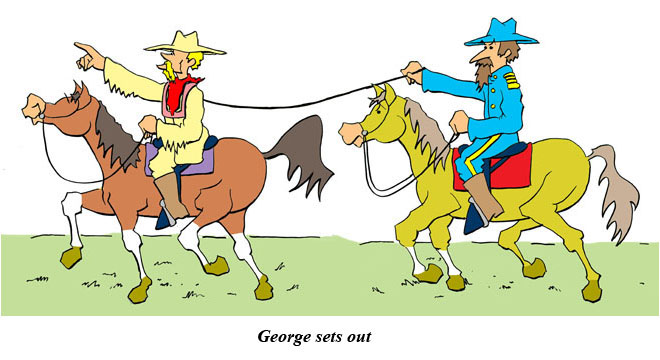
Usually the stories of the Little Bighorn start off with George heading off from Fort Lincoln with the band playing "The Girl I Left Behind Me". This account is no different. On May 17, 1876, George, Tom, Myles, James, Marcus, Frederick, and the rest of the 7th Cavalry (including Bos and Autie Reed) set out with the band playing "The Girl I Left Behind Me".
Oh, yes. Despite the orders of President Grant about bringing along reporters, there was Mark Kellogg. Mark was, as we said, a reporter for the Bismarck Tribune and had been spending his time at the fort eagerly writing dispatches and articles about the dashing General Custer. Given Grant's orders this seems like audacity and insubordination on a massive level.
Weeeeeeelllllll, not quite. We need to remember the man actually in charge was Alfred, not George. Mark, then, was officially attached to Alfred's command. In fact, it was only a couple of days before the battle that Mark asked to accompany George specifically. Alfred said fine, go with George. Nonetheless from his writings it's clear Mark had always intended to write about George, not Alfred, and wherever George went, so did Mark.
George's route after the Indians is known pretty definitely. He and Alfred went west until they reached the Yellowstone River. Then they moved upstream (which was southwest) until they came to the Rosebud creek (today conveniently situated on Interstate 94 about 100 miles east northeast of Billings). George and Alfred then split up, and George continued south along the Rosebud. He then found the trail of the Indians (a village on the move leaves tale-tell signs where the travois scratch up the ground). He turned right and after a short march struck the Little Bighorn where on the night of June 24, they were within a day's march of the village. Lest again confusion arise at this point, the Little Bighorn, like the Nile, runs (sort of) south to north. So "upstream" means moving "down" south, and "downstream" means moving "up" north.
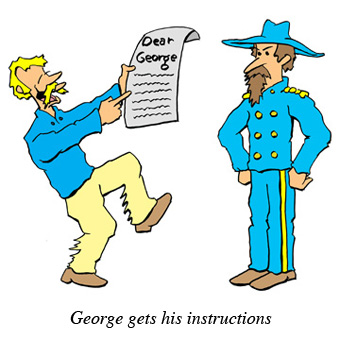
A big point of controversy is whether George, moving as he did, violated his orders from Alfred. After they parted company, Alfred sent George a note saying that he, Alfred, wanted George to go south (upstream) along the Rosebud (as George did). But even if the Indian trail headed west toward the Little Bighorn (as it did), George - and pardon us if we shout - was to keep going south even as far as the headwaters of the Tongue River (which parallels the Rosebud). This was to make sure there were no other Indians around. Only then would George turn and move northwards (and downstream) along the Little Bighorn. George and Colonel John Gibbons, who was leading his troops in from the north, would have the Indians boxed in along the river.
But - and it's a big but - Alfred had not really given George orders at all. Instead, he gave George "views" of what he'd like George to do. After all, Alfred told George that he "places too much confidence in your zeal, energy, and ability to wish to impose upon you precise orders which might hamper your action when nearly in contact with the enemy." Still, Alfred said, he wished George to conform to his "views" - and here's the real kicker. - "unless you [George] shall see sufficient reason for departing from them."
That's right. Unless George sees sufficient reasoning from departing from them. Not if Alfred sees sufficient reason. Not if General Sherman sees sufficient reason. Not if extraordinary circumstances which would otherwise imperil the success of the mission requires he depart from them. Nope. As long as George sees sufficient reasoning from departing from them, then George could depart from them.

Now historians who don't like George have said that these "views" really were orders, and Alfred was just being nice. But Alfred didn't talk that way to everyone. Marcus, in fact, had earlier been sent on a scouting expedition. Alfred gave Marcus a specific itinerary with no leeway at all. For one thing, Marcus was to go down the Powder River (there were a lot a rivers in that region) and then loop west and come back north to camp along the Tongue River. Marcus's orders were not to find the specific Indians that George and John were going to catch, but just to see if there were other Indians around. So under no cirumtances, Alfred (verbally) told Marcus, was he to go so far west that he would strike the Rosebud.
Marcus for some reason did the exact opposite of what Alfred said to do. After he turned west, he did keep going until he reached the Rosebud. Sure enough, he came across the Indian trail and so provided Alfred (and George) with precise information as to where the Indians were heading. But Marcus had been given orders for the route he was to take - not "recommendations" or "views". So Alfred gave Marcus a royal chewing out once he got back, and George thought it was lucky Marcus didn't get court-martialed. Then in a revealing statement, George added that if Marcus had violated his orders but had gone on to catch the Indians, then that would have been OK.
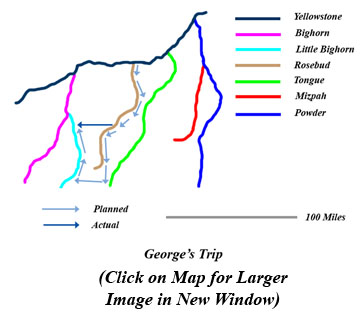
Which brings us to some things to consider in understanding George's actions. Were George to depart from Alfred's "views" and catch the Indians, then George would be once more a superb Indian fighter and a brilliant field strategist. But let George depart from Alfred's views and let the Indians get away, then he could kiss his military career good-bye. George knew this full well and that helps explain his strange demeanor during his last staff meeting. The officers remembered George as unsure of himself, and shock of all shocks, said he even welcomed suggestions. That was not the George Custer they had come to know and love - or at least know.
Why did George change Alfred's plans? Those who don't like George (including Frederick Benteen) say he just wanted the Indians all to himself and was a glory hunter. Why, they add, George even said so himself! As George was leaving the Yellowstone to head down the Rosebud, John Gibbon had called out, "Now Custer, don't be greedy! Leave some Indians for us!" George, with unwonted good humor and ambiguity, called back, "No! I will not."
On the other hand, George's friends say following Alfred's orders would not have covered George's buckskin clad backside for one minute. Four months earlier Colonel Joseph Reynolds and his men attacked an Indian village on the Powder River. Joseph had done as good a job as possible under harsh winter conditions, marching through heavy snow, and he had not been given adequate support by his superiors. Still he managed to capture the Indians' rifles, ammunition, and horses.
But the Indians got away and Joseph was summoned for court-martial. All the legitimate extenuating circumstances in the world notwithstanding (not to mention his friendship with President Grant) did Joseph no good. He was found guilty and soon left the army. So George knew if the Indians got away, he'd be in the same fix. Whatever George did had better work!
In the end, George did not proceed to the headwaters of the Tongue nor (as Alfred also wanted) to explore Tullock Creek. Instead, and doing the opposite of what Alfred recommended, George turned and followed the Indians toward the Little Bighorn.
So on the night of June 24, 1876, George and his men were camped about fifteen miles from the village. With some irony, they were on the Crow Indian reservation (still extant today). Then early on the morning of June 25, everyone got up and began to move. By the afternoon they had closed the distance to about five miles. One problem, though, is George's Indian scouts (led by Lieutenant Charles Varnum) had seen some Indians and the Indians had seen them. That meant the Indians might strike camp and run. So rather than wait for the next morning, George decided to attack that day.
Marcus Takes the Lead
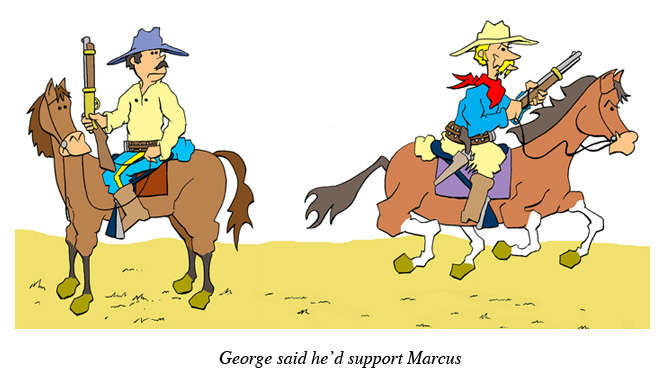
George had not found an Indian village. It was actually about seven, all fit snugly onto a little floodplain along the meandering Little Bighorn River. A number of tribes were out and about, mostly Sioux (Lakota) with Cheyenne but with some Arapaho as well. Sometime around mid-June the disparate bands had crossed paths and joined forces. Now everyone was together in what was essentially a large conglomerate village along the flats west of the river, with high bluffs to the east and south.
It's sometimes said the Lakota chief, Tatanka Iyotaka, also known as Sitting Bull, led the battle. Certainly, Tatanka was an influential elder and as a young man was known for his bravery. But as we said, the Plains Indians did not have leaders in the sense that European based governments do. And in a village that was composed of different tribes with languages as different from each other as Chinese is from English, there was no one person or group of people in charge.
That doesn't mean there were no leaders; they just led, and if others wanted to follow, they could. Certainly prominent among the warriors was Tashunka Witko, known to most western history buffs as Crazy Horse. Tashunka was in his late twenties and had established himself as a fearless and relentless fighter. Another Indian who played a major role in the battle was the Cheyenne Kumokwiviokta. Kumokwiviokta is better known as Wooden Leg since he had the ability to walk all day without tiring. George's nickname, "Iron Ass", was a simular tribute toward his ability to stay in the saddle. (And what else could it mean?) Finally, there were the Lakotas Pizi (Gall) and Itonagaju (Rain-in-the-Face).
As George and the soldiers moved west along a tributary of the Little Bighorn, George gave instructions to Marcus and Frederick. Frederick he sent to scout to the west to see if there were any other Indians around. If not, he was to return. Frederick, ever suspicious of George, felt he was just being sent off on a wild goose chase.
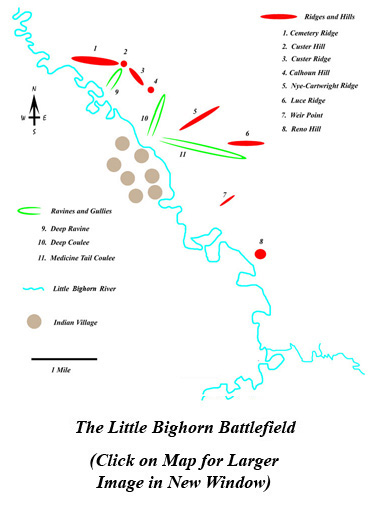
But George told Marcus to advance as fast as prudent and attack the village. His own command, that is, George and his men, would support him.
What George's exact plans were he never said, and what was in his mind must remain speculation. Possibly he intended to cross the stream a bit further north and join in the attack by coming in on Marcus's right but was deterred because he couldn't find a suitable place to cross. Alternatively, he could have thought to try the same tactics that worked at the Washita. That is, he would attack the village from another direction, either at the middle, or if it was not too large, at the opposite end from Marcus.
Whatever his intent, George soon lost sight of Marcus. The land at that point is rough and rises fairly quickly to the north. Also it is difficult to cross the river until you get to a ford at the mouth of a gully called Medicine Tail Coulee. Medicine Tail is also about three miles north of where Marcus began his attack, and there is really no quick way there.
Despite George's concern that the Indians knew the cavalry was on the way, the Indians themselves said Marcus's attack caught them completely by surprise. But by beginning the attack two miles away, Marcus gave the Indians plenty of time to begin their frenzied preparation for battle. They not only had time to go and fetch their horses from the fields, but they even had time to stop and get fixed up with their favorite war paint. Some (like Crazy Horse) even took the time to perform various rituals to protect them in battle (which seemed to work). So well before Marcus reached the village, the Indians were on their way to meet him. Startled both by the sheer numbers he was up against as well as the simple fact the Indians were attacking and not running, Marcus looked around for George and his "support". But there was no George.
Meanwhile, Back At the Village
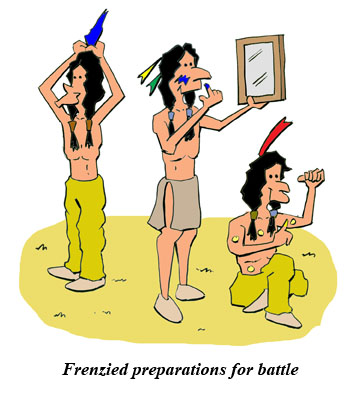
The "promised support" - or rather, Marcus not getting the promised support - became a major theme with Marcus. Much like Frederick harping on George speaking with a stammer, if there's one thing we learn from Marcus, George had promised to support him. He kept going at it like a broken record. But to be fair, we don't just hear this just from Marcus. A number of Marcus's men also said they heard George's promise, so there's no reason to doubt it.
The most common estimate is that George and his troopers were up against between 1500 and 2500 warriors which fits well with the number estimated by some of the soldiers. It also agrees with a scale of a village that was a mile long and kept within 300 yards of the river. In that case, the village would occupy 109 acres (reports that the village was two to four miles long and a mile or two wide are certainly exaggerations). Again from photographs of nineteenth century Indian villages we can estimate the lodges per acre at between ten to fifteen possibly a bit toward the lower end. Having some space between the individual villages we end up with perhaps 1000 lodges. Averaging two fighting adults per lodge (one head of the household and a son of fighting age) we have - surprise! surprise! - 2000 warriors. You can jiggle the numbers in other ways, but 2000 warriors is a not a bad guess.
So whether you think Marcus and his men were up against 2000 warriors (the median guess), only 900 (a lower estimate based on modern scholarship) or even 12,000 (an early but grossly inflated estimate calculated from the number of Indians left on the reservation), they fanned out toward the village. According to the Indians, bullets fell among the lodges. Although most of the shots went high, among the first casualties were women and children.
Again we emphasize that this modus belli was the way it was done and is not just an invention from tear jerker Hollywood movies. Although it wasn't policy to kill Indian women and children, it was a rare soldier who really cared if it happened. Even soldiers deliberately shooting of women and children are attested. During the - quote - "Battle" - unquote - of the Washita, George himself was sitting on a hill watching as some of his soldiers shot down fleeing women and children. He only called a halt to it when his chief scout, Ben Clark, objected.
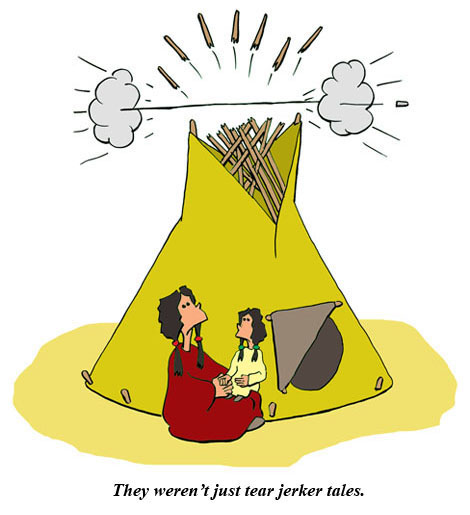
In fact, the very first casualty of the Battle of the Little Bighorn had happened already and was a ten year old Indian boy named Deeds. Deeds had been out and away from the village and came across a box of hardtack. As he sat on the box and was nibbling on the brittle and inevitably tasteless crackers, a group of troopers - actually the ones who dropped the box - came by. They immediately opened fire and hit Deeds in the chest. He died immediately. Such an act was, as we said, not policy, but no one ever got into trouble because of it.
Of course, it's easy to counter the killing of Deeds with stories where the Indians were not always sweethearts themselves. Far from simply tapping their opponents with a coup stick (as suggested in the movie Little Big Man), there's no doubt that Indians sometimes killed women and children when attacking white settlements. The actual number of settlers killed in the western Indian Wars are not known, but are usually estimated in the hundreds. At the Battle of the Washita it was also documented that a white captive named Clara Blinn and her son were killed by the Indians once the cavalry began their attack. Also during the Minnesota Sioux uprising of 1862 there were over a hundred settler deaths, and there were undoubted cases where even young farm children were killed, tortured, and mutilated. As one Lakota writer said, the Indians were human beings, too. Some things they did were noble and elevated; others were pretty horrible. So trying to debate which side waged the more pleasant mode of warfare is kind of pointless.
But all this historical analysis and soul searching didn't help Marcus much. When he led the attack, he didn't ride boldly into a village, scattering panicked warriors and their families in all directions. Instead, Marcus found himself facing irritated, angry, and mounted warriors riding out to meet him. And still there was no George.
Marcus Blows His Cool
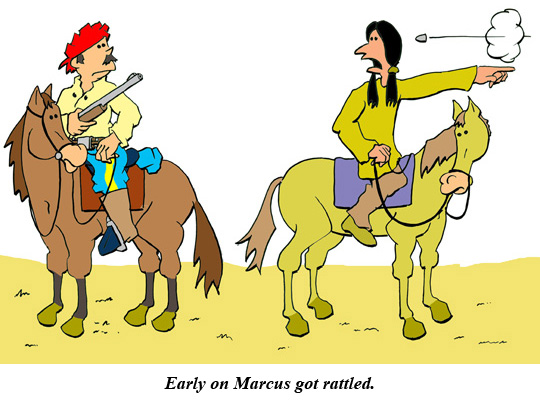
The first report about the Battle of the Little Bighorn was written on July 27, 1876. It was from Marcus to Alfred. He states that he had a most terrific battle with Indians and had nearly a hundred dead and wounded and could not possibly move. He added he had seen nothing of General Custer since George ordered him to attack and promised to support him. So obviously things had not worked out like he and George expected.
As Marcus and his men charged, they saw something they never expected. The Indians were actually coming out to fight. So with no support from George and still a few hundred yards short of the village, Marcus ordered his men to dismount. Following proper procedure, they formed a skirmish line.
It's here we, like Marcus, must pause because we have come to the first major battle among the historians. Was Marcus's command to dismount and deploy the correct one? Or should he have kept charging? Why did he stop?
From what some of the men said and at this early stage, things didn't look too bad. They even congratulated themselves on a few well-placed shots. So when Marcus ordered his men to dismount it's likely he did so primarily because he had not received George's promised support. In his opinion, he was supposed to attack the Indian village if - and it's a big if - George came in with him.
At this point, though, we have to discuss semantics and definitions. Certainly in George and Marcus's time, "providing support" usually meant the supporting column would follow behind the first wave of attack. Alternatively it could be a flanking move at or near the same time as the principal charge. But whatever the details, an officer saying he'll provide support normally means there is a more or less simultaneous, or at least coordinated actions by the two companies.
The fact that the Indians were coming out to fight also threw the plans out of kilter. The success of attacking a village largely depended on soldiers being in the village itself. Pandemonium would reign, and the warriors would be more concerned about protecting their wives and children than killing the soldiers. That clearly wasn't happening. So the plans had already gone awry.
As Marcus and his soldiers kept fighting, more and more Indians began to show up. Soon they were turning on his left flank, attacking from both the north and west, and some were even moving around behind. According to Marcus, Indians literally seemed to grow out of the ground, and he decided he couldn't stay where he was, particularly as there was still no George.
Since he had begun charging from about two miles from the village, Marcus also had time to dispatch two messengers to tell George that the Indians were coming their way and in force. One of the civilian scouts, Frederick Girard, also crossed the river and found Lieutenant William Cooke, George's adjutant with the humongous side whiskers. Fred also said the Indians were attacking, and William said he'd tell the general (again a reference to George's brevet rank). We know the messengers that Marcus sent also reached George since they were found later (and dead) with Custer's command.
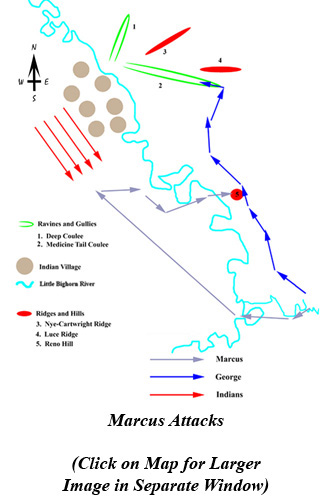
So before George even started his own fight, he knew that Marcus had halted his attack. In fact, George might have been watching the action himself. Some of Marcus's men reported they looked up and saw some of George's men (perhaps George himself) waving their hats from the high bluffs. George may very well have thought this was a good thing. A skirmish with Marcus would keep the warriors occupied, and now George could now ride into the village and give his promised, but now belated, support. Better, if anything went wrong, he could blame Marcus.
So whether Marcus halting the attack was the right thing for him to do is a more complex decision that it seems at first. But for historians who want to pass judgment - none of whom were with Marcus or George at the time - the sentiment seems to depend on whether you like George or not. If you do, then Marcus should have kept going, and by not doing so, he disobeyed his orders. On the other hand, if you don't like George, then you say Marcus did the right thing, and he saved his men from certain annihilation. Most of the troopers who were with Marcus said he did the right thing. But then nobody really knows what would have happened if Marcus had kept going because Marcus didn't keep going.
But we do know what happened when Marcus ordered a halt. Following the proper skirmish tactics, every fourth man took the horses for three of his comrades and retired a ways back of the line. That knocked down the number of fighting men to a bit over a hundred. Although the holders moved off to some trees to get under cover, the sound and the fury made the animals hard to control, and some got away. Soon a number of the men found themselves on foot, facing a charging mounted enemy, some of whom had better rifles and could shoot better. This was not a good situation for the average soldier in the ranks.
Even though all the warriors were not yet in the battle, Marcus could easily have been trying to fight 500 Indians. With a strong front charge from the village and Indians moving toward his left side and some circling from behind, the best cover Marcus saw were the trees to his right and close to the river. So he ordered all the men to the timber. Unfortunately, cavalry trying to maintain an orderly formation in woods isn't easy. With even more Indians on the way, the soldiers rapidly began to loose any confidence they may have had at the start.
It's even worse if something happens that rattles your commander. Early on Marcus lost his hat, and he had tied a handkerchief around his head. That may have been what caused the final problem. As the fighting continued, Marcus was talking to an Arikawa Indian named Bloody Knife. Whether the Indian bullet was actually aimed at the now colorful head of Marcus or not, it hit Bloody Knife square in the noggin.
Again the accounts of Marcus's reaction vary a bit. The men who later testified about the battle reported him "excited" but still in command and taking nips from his whiskey flask (before leaving the fort, Marcus made sure he had a half gallon keg available for the trip). A more popular image, particularly if you like George, is that Marcus found himself besplattered with bits and pieces of Custer's favorite scout and completely lost it. He immediately ordered his soldiers to mount up. Then he ordered them to dismount. Then he ordered them to remount again. Finally he ordered them to get the hell away across the river.
Now we have something pretty rare in accounts of the Little Bighorn. Historians actually agreeing on what happened. The soldiers retreated across the river with Indians riding up beside them and either picking them off with their rifles or knocking them from the saddles with war clubs. Marcus, leading the men in what can only honestly be called a panic, crossed the Little Bighorn and took them up to the hills. When one of his officers mentioned the men seemed demoralized by the rout, Marcus replied, "That was a charge, sir!"
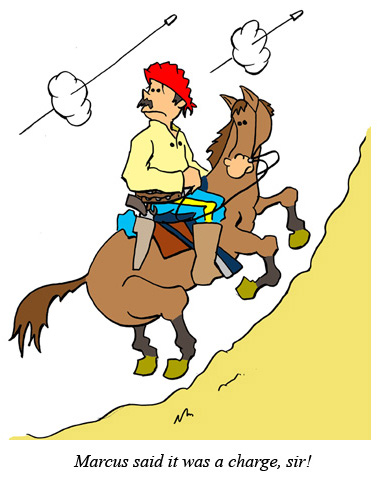
All right. Should Marcus have kept going into the village? Despite the common belief that orders are orders to be obeyed with a "Sir, yes, sir!" type of military rigor, officers have considerable leeway in making decisions when under fire. If an attack is underway, and they find part of an agreed on plan hasn't been correctly executed, they can adjust their actions accordingly. Even retreat and surrender is a very proper option if you're about to be wiped out. So Marcus stopping the attack was within the scope of legitimate discretion.
But that doesn't answer the question whether it was the best thing to do. Even some Indians said it wasn't. If Marcus had kept going, they said, his attack would have been successful. But of course, there were plenty of others, both Indians and white, who disagreed. They said if Marcus had kept going, he and his men would have been wiped out. After all, why should you criticize Marcus for not defeating a group of Indians with 150 men when the same Indians turned around and rubbed out George with 210?
Whether we like George or not, we have to concede he did make a mistake by not providing Marcus support as the word was usually understood. Or at least by not sending word if he had changed the plans. But Marcus had also had made a mistake, and it was a whopper. If there was one thing Indians could do it was to overtake and kill a fleeing foe. So if you were fighting Indians, you never - that's NEVER! NEVER! NEVER! - ran without providing an organized rear guard. That Marcus did not do.
Finally Marcus and everyone else reached the top of the bluffs. Some men got left behind and were killed. Others hid in the brush and timber and eventually made it back. In any case, as everyone reached the top, and the men dug in, Marcus had to wonder. Where was George?
Meanwhile Back with George
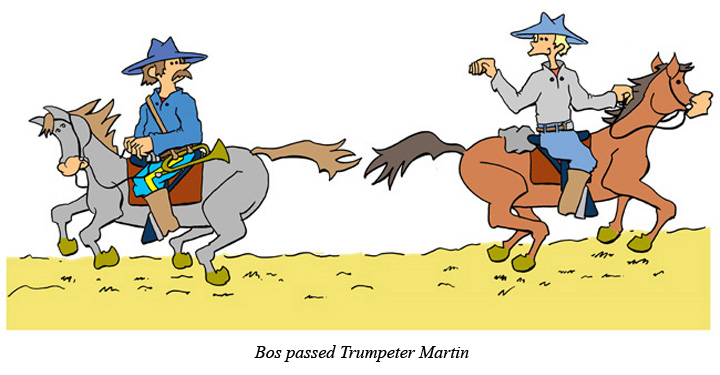
All right. So where was George? He certainly hadn't provided Marcus with any support. So just what the heck had he been doing for the last hour?
We do know that George and his command continued along the east side of the river where the lie of the land forced them to higher ground. There, near the head of Medicine Tail Coulee (as we said, about three miles north of where Marcus started his attack), George and his troops could finally see the village. And it was big.
As usual, it's not clear what George thought. Two men later said George thought the Indians were caught unawares and were running. Seargant Daniel Kanipe, who George immediately sent back to the ammunition pack train commanded by Captain Thomas McDougall, said George called out "Boys, we've caught them napping!" At first Daniel was a bit miffed that he had been sent on such a pedestrian task like carrying a message rather than riding to battle and glory. Later, though, he changed his mind. Private John Martin, soon dispatched to find Frederick, said it looked like the Indians were running away.
Strictly speaking, George was at least partly right. The Indians, if not napping, at least were running away, if by that we mean they were leaving the village. Remember by this time Marcus had already been driven back, and a good number, if not most of the warriors were already outside the village. Others were on their way out, either to join in the fight or running to get their horses from the pony herd. The women and children were striking camp and heading north.
As we said, George's actual plan is not and cannot be known. Perhaps even he didn't have a clear idea of what he was going to do. But some historians believe George was thinking in terms of the Washita. If so, his intent was to capture the women and children. But whatever his plans, when he saw the size of the village and the number of Indians, he knew he needed more men.
So George turned to Trumpeter Martin. He told John to go find Frederick (who we remember had been sent to scout the west) and tell him to hurry along. Reinforcing the order he gave to Daniel, George told John to have Frederick bring the ammunition packs. One problem, though, was that John (born Giovanni Martini in Italy) only had a rudimentary grasp of English. So Lieutenant Cooke, now back with George (and who normally transmitted George's orders down the line), penned a note with the instructions. He handed it John who promptly rode off.
The fact that George sent a couple of troopers off individually indicated he didn't believe the situation was particularly serious. He had no doubt that John would reach Frederick and Daniel would find Thomas. Frederick and Thomas would then move forward with the men and ammunition. So even if Marcus was huddled up on the hills, he, George, would still best the Indians. The main thing was to catch the women and children.
Soon still one more event happened that made George think all was well. His younger brother, Boston, rode up. Bos had been back with the ammunition pack train, but wanted to be where the action was. On his way he passed Trumpeter Martin and asked where his brother was. John pointed the way.
So there you are. The women and children were hurrying off on foot (easily caught). There was Mark Kellogg happily taking his notes. Then Bos rode up. Shoot, if a neophyte scout or newly hired forage master (take your pick) could get through in short order, then Frederick and the pack train must be right behind. Yes, Marcus may have halted his attack, but that would keep the warriors busy. So there wasn't anything to worry about. After all, this was Autie Reed's summer vacation.
Frederick Helps Marcus
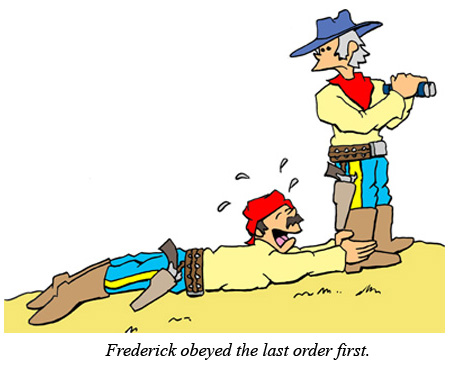
The problem was that as George stood looking down at the village, Marcus was not only drawing the Indians off but was also having his tail whipped. As he - quote - "charged" - unquote - up to the high ground, he lost perhaps 30 troopers killed, 20 or so missing (but later made it back to Marcus), and about 15 wounded. At least, though perhaps fortuitously, he had picked a good place for defense.
All this hooplah took about an hour. Fortunately, though, as soon as Marcus reached the top of the bluffs - now the Reno-Benteen Battle Site - Frederick came along. Frederick had found no Indians and had already been returning to George. Then Private Martin had ridden up and handed him George's - or rather William's - message.
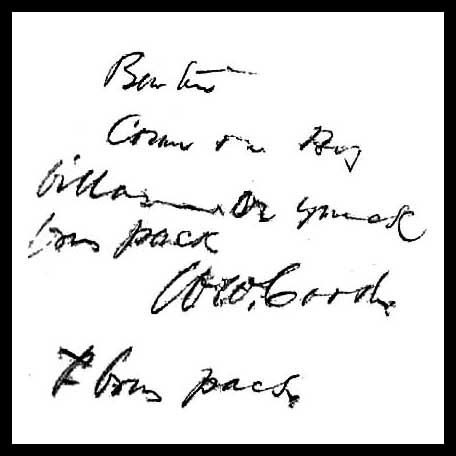
After reading a message that's even less comprehensible than John's English, Frederick asked what the Indians were doing. John, who like the others though he had seen the Indians hurrying away from the village, said they had "skedaddled."
(As an aside, through Herculean efforts of cryptography, epigraphy, and linguistic studies of nineteenth century American English, the best people have been able to guess is that the message reads, "Benteen - Come on. Big village. Be quick. Bring pack[s]. W. W. Cooke. P. [S.] Bring pacs [sic].").
Frederick wasn't certain what the heck he was supposed to do. "Be quick", the message said, and bring along a bunch of mules? Why did George need the pacs [sic]? Were there so many Indians he needed that much ammunition? Or did George just want to protect the train from the Indians? Knowing McDougall was in charge of the pac [sic] train, Frederick interpreted the "bring pacs [sic]" part as being orders for Thomas. So he sent John on to tell the pac [sic] train to hurry along. Now Frederick was able to "be quick". He ordered the men into a trot, but it was a pretty stiff trot, since one lieutenant with him, Edward Godfrey, said they actually moved at a gallop.
Frederick and Marcus reached the top of the high bluffs at the same time. The first thing Marcus said was "For God's sake, Benteen! Stay and help me! I've lost half my men and couldn't have done anything more!" So evidently Marcus himself realized that he needed to start justifying his actions during which - as a later inquiry found - if not acting improperly, he had scarcely distinguished himself. He also couldn't count very well.
Frederick asked where George was, and Marcus said that he hadn't seen him since (sigh) George said he would support him. Now Frederick was really confused. George was supposed to support Marcus, and here was Marcus. Was George supposed to show up? Should they wait for George?
At this point, then, George's friends now turn their sights on Frederick. By staying to help Marcus, they say, Frederick disobeyed George's orders. George, after all, told Frederick to "be quick" and "bring pacs [sic]". Regardless of what George told Marcus about support, Frederick was obliged to be quick and bring the pacs [sic] to George.
Not so, say Fredericks' friends. Frederick and Marcus were now in a complex, evolving, and dangerous situation. Furthermore, Frederick's critics misunderstand the manner in which military orders are transmitted and should be obeyed.
Far from disobeying orders, Frederick, they say, did follow proper military procedure. Orders, they remind us, are generally transmitted down the line. The final person receiving the orders rarely gets the command from the head honcho. Furthermore, there are proper rules to follow when receiving apparently contradictory orders from two superiors.
So Frederick did exactly what he was supposed to. He obeyed the most recent order first. That was from Marcus, superior to Benteen, to give him help. This superseded, or at least postponed, the action of the first message.
Hold, on there, say George's friends. The message to "be quick" was from Colonel Custer and had precedence over a panicky request by Major Reno. Benteen did not follow proper precedence.
No, no, no, answer Frederick's champions. The orders strictly speaking were from and signed by Lieutenant Cooke. So by obeying Marcus, Frederick kept in line with the proper chain of command. Frederick did exactly what he was supposed to do.
The problem with all this brouhaha is that we're trying to decide if what Frederick did was militarily correct. That question is obviously not a simple one, and besides, is largely irrelevant. Instead, we should ask if Frederick did the best thing given the circumstances. Of course, there is no really clear cut answer here either, or at least no answer that everyone agrees on.
Even at the time, some of the officers said Frederick should not have stayed with Marcus but should have gone off to find George. Lieutenant Thomas Weir, who liked George and (according to Frederick) really liked Libby, went up to Marcus. The usual interpretation of the unintelligible shouting match that followed was Tom was asking permission to go find George. Whatever Marcus said, Tom, guided by the sound of gunfire, headed off. The soldiers who were with Tom assumed permission had been given, albeit reluctantly. But Tom said he neither waited for nor asked for permission. Frederick (later) said Tom had been sent to establish contact with George. More likely, Tom asked Marcus permission, Marcus said no, and Tom headed out anyway. Whatever the truth, Tom went to find George, and Frederick and Marcus soon followed along.
Everyone made it about a mile north to the high peak now known as Weir Point. They looked down and saw Indians riding around and firing their guns at objects on the ground. Many authors interpret this as their seeing the end of Custer's Last Stand. The distance from Custer Hill and Weir Point, though, is about two miles - a long way to see through dust and smoke. So others believe Tom saw earlier fighting on what is called the Nye-Cartwright Ridge. But whatever action they saw, the bullets came whizzing their way, and the Indians started charging. Once more the Indians' sheer numbers sent the soldiers in quick retreat. But in this case, at least, Frederick had told Edward Godfrey to place soldiers as a rear guard. Only one man was wounded when he was struck in the thigh and was left behind. He was later found dead.
Waiting for Frederick
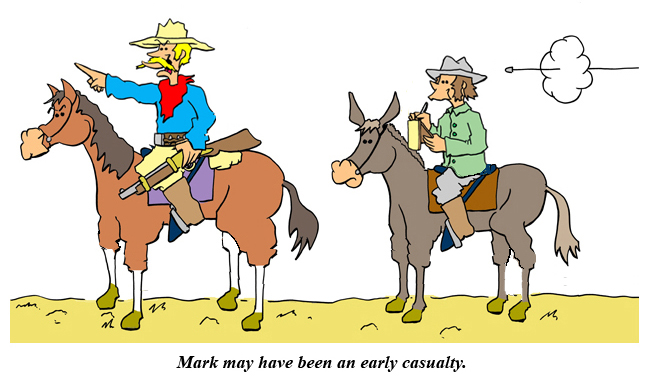
Traditionally when John headed out with the note to Frederick, the living, breathing, George Armstrong Custer vanishes from history. Exactly what he did and where he went has been discussed, argued, analyzed, and debated ever since George and his 209 men were found strewn over the battlefield. After all, we've been told there were no survivors.
Which, of course, isn't true. Like in all battles, there were survivors. They were just on the other side. Within a year, Indians began to tell their side of the story, and piece by piece - and from archeology conducted at the battle site itself - various possibilities for George's movements have been established. There are still a lot of unknowns, which is fine for people who like to argue and debate about things that happened a century or so ago. After all, nothing adds more fun to the study of history than not knowing what went on.

The first reconstruction of the battle was within a couple of days after it was over. When General Terry arrived, he and others went over the field. As far as they could tell, George went down to the ford at the mouth of Medicine Tail Coulee where John left them. It looked like George tried to cross the river, but couldn't make it. The trail then turned back on itself, and making a counterclockwise loop, ended up on what is now called Custer Hill. So what it looks like happened is when George tried to charge into the village, he was met by so many Indians that he was driven back and eventually wiped out.
There's at least one problem to this reconstruction (shown in the map below). The Indians said there were not more than a handful of warriors at the ford. So it's not likely a determined battalion wing could be stopped. Also Indians said they had seen George once more divide his command. That is he sent one group of men - two or three companies, actually - to the river while the other companies under his command stayed behind.
That George divided his command before heading down to the river has been pretty much accepted by modern historians. We don't know, though, whether George went to the river himself or not. Some think he did; others he didn't.
One reasonably popular theory - and with some good arguments - is George did go with the troops to the river and was shot at the crossing. Then panic took the men, and they scurried away with their dead or mortally wounded commander, possibly retracing their steps back to what is now called Luce Ridge and not too far from where they started down Medicine Tail Coulee. There under fire from the Indians who had left the battle with Marcus and Frederick, the men moved northwest across Nye-Cartwright Ridge to Calhoun Hill. After fighting there and Indians still closing in from the south and more circling to the north, the surviving troopers moved along Custer Ridge to Custer Hill (carrying their dead or mortally wounded leader with them). After a valiant stand with the Indians surrounding the hill, Custer's troopers fought until the last man died.
This alternative picture would still fit in nicely with what Alfred saw. If George was shot trying to go into the village, you would expect the troops to turn back, if for no other reason than to regroup and decide what to do next. More importantly, if the men deliberately withdrew after George was hit, then that would explain how a handful of Indians seemed to drive back a couple of companies of mounted soldiers.

The Little Bighorn - Version 1
Then there is the testimony of an Indian named White Cow Bull who said it was he who shot Custer at the ford. When talking about his role in the battle, White Cow Bull said that at the crossing he shot a buckskin clad soldier off of a sorrel horse with four white stockings. That, we learn, exactly fits the description of George and his favorite horse, Vic. On the other hand, historians (and some Indians) haven't bought into White Cow Bull's story. After all, White Cow Bull told the story more than sixty years after the event, and by the 1930's and 40's, the picture of the dashing buckskin clad Custer was pretty universal and could have become assimilated into the Indian oral tradition - or at least as reported by somewhat biased white historians. That there was only one horse with four white stockings may also be questioned, and it is known that other officer's wore buckskin jackets and pants including George's other George, Captain Yates. Besides, the picture of George standing tall at the Last Stand is an image a lot of people just don't want to give up.
Which brings us parenthetically to why we'll never know for sure what really went on. Because the source material comes from such a diverse cast of characters - soldiers, officers, and Indians - many of whom were under considerable stress that day and saw only a piece of the action, the tales are confusing and contradictory. Sometimes you can't even tell what the person is referring to. An Indian may say he saw the soldiers separate. Where was this? Before they reached the ford? At Calhoun Hill? It may even have been a reference to George and Marcus dividing up before the attack. They say soldiers reached the river. At Medicine Tail? Was it Marcus in retreat? George further north? Not surprisingly then, some historians will put an informant at one place on the battlefield while another chronicler will put the same person witnessing the same action miles away and at a different time.
It's not only vagueness and the sketchiness of the stories that cause problems. Sometimes we have too much detail even if - or we should say especially if - the teller claims he saw it with his own eyes. One historian, for instance, points out that White Cow Bull seems to have seen just about everything first hand. If some Indians reported a trooper fleeing only to be shot down, White Cow Bull was there to see it as well. A young Indian saw a Lakota with a warbonnet get shot on Custer Hill, well, White Clould Bull saw it, too. Several Indians saw a fleeing trooper nearly get away only to pull his gun and shoot himself. Yep, White Cloud Bull was also an eyewitness. Then of course, Indians say they saw a buckskin clad soldier fall at the ford. White Cow Bull tells us he not only saw it, but he fired the shot.
Sorting out what happened to George is all the more of a problem since we have to deal with Indian accounts that were often told through translators. What may be have been really told as a second hand account ends up as being related as a story of an eyewitness. Also people are people. Some will tell a story straight up as they saw it. Others will forget, misremember, embellish, and even fabricate. So to put together a coherent picture, you need to weigh some stories more than others and perhaps discount others altogether.
More to the point, the selective process depends on the historians and their background as much as anything. Historian Robert Utley couldn't have put it better when he said how we see Custer depends on who we are. If we believe Custer was heroic and a military genius, we will see in his actions all the makings of a heroic military genius. If we believe he was a reckless and glory hungry martinet, we will find in his actions all we need support our belief. There's also environment of the historian to contend with. In the World War II era when the Greatest Generation was saving the world by force of arms, George was a hero. During the Vietnam era with its suspicion of authority, George was a jerk. And of course, the cycle continues today.
However, the consensus, whether right or wrong, seems that George was not killed at the crossing. One military argument is that if he had been, then, the command would have passed to the senior officer with him, who was Captain Myles Keogh. So George's personal staff - called "Headquarters" in military jargon - would then have attached themselves to Myles. But Myles was found - and surrounded by his command - on the rise between Calhoun and Custer Hills called Custer Ridge. George's staff were found with him at Custer Hill. All this all makes more sense if George stayed alive and in command until near the end.
So the alternate theory is George did indeed send George Yates to the crossing and it was the other George that the Indians killed. The soldiers at the ford retreated back from the river, and George (Custer) moved from Luce Ridge to Calhoun Hill where the two groups rejoined. After losing a good portion of the men at Calhoun Hill, the survivors moved to Custer Hill only to be wiped out.
This picture - or similar ones - has been largely the one most constructed by mainstream historians. The only trouble with this theory is that Yates was also found on Custer Hill. If the soldiers could have dragged one George around the battle, they could have dragged the other. But for our purposes, we'll have our George staying back and not going to the Medicine Tail ford. If nothing else, it does make a bit better story.

The Little Bighorn - Version 2
There's still a third theory based on both Indian tradition and testimony and archeology that was conducted in the 1980's. This is the picture that more recent authors seem to accept. Here we say that George himself did not go to the ford at Medicine Tail Coulee, nor did he wait. As Yates (or whoever) went to the ford, George (Custer, that is) continued further north and west. Possibly he, Myles, and James waited at Calhoun Hill for the group from the ford. Alternatively, perhaps James and Myles were to stay and wait for Yates (and Frederick) while George rode on.
In any case, George left a good part of his men waiting on Calhoun hill while he kept going along the ridge and past Custer Hill. He then turned left and went down near the present day entrance to the park by the river. Evidence for this trip came from the finding of soldiers' cartridge cases and Indian bullets on what is now called Cemetery Ridge nearer to the entrance. Even more persuasively, that's close to where a body identified as our intrepid reporter, Mark Kellogg, was found. Mark (if it was Mark) was then well away from the main battle action when he was killed.
This last theory of two separate trips to the river makes sense particularly if George was intent of capturing the women and children. When Marcus attacked the village, the non-combatants quickly headed off north and collected at an area about even with the modern park entrance. George would naturally head in that direction. Some Indians (particularly the Cheyenne) said they did indeed see George down there by the river. Putting it all together, then, it looks like 1) George went further upstream than previously believed, and 2) a well placed Indian bullet, likely fired from long range and across the river, made Mark Kellogg America's first war correspondent killed in combat.
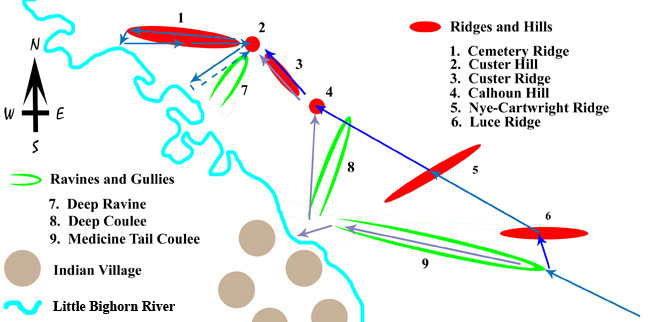
The Little Bighorn - Version 3
So here then is a reasonable scenario which tries to put all the confused and disjointed pieces together. After he left Marcus, George headed north on the east side of the river. He then sent two or three of the companies (possibly under Yates) to the ford at Medicine Tail Coulee. Why is anyone's guess. Having separate groups move into a village is certainly like his two pronged attack at the Washita. It worked then, George thought, so why not now?
Or it could have been, as historian Robert Utley suggested, a feint to draw the Indians away from Marcus. Another explanation is sending troops across the river would have driven a barrier between the women and children and the warriors. Or, who knows? There might have been some other reason.
Once the first group went to the river, George and the rest kept going to Calhoun Hill. Here he either waited for Yates with James and Myles and their men or he left them there and kept going further north. He then turned left and went down by the river across where he saw the women and children congregating. But by now with the division of the various commands, he probably only had 40 or 50 men with him, and he could see warriors were also heading his way.
This was the time that the commands under George began to recieive serious long range fire from the Indians, and his soldiers began to be hit. One of the men killed down by the river was Lieutenant James Sturgis, the son of the 7th's commander. Possibly George never learned that his commander's son had been one of the early casulties but it was a very bad omen. But now even if George succeeded in his mission, he would now be #1 on the short of list of Colonel Sturgis' least favorite officers and Colonel Sturgis might gleefully seize George's departure from Alfred's views as a basis for court-martial. That was if George was luckly and caught the Indians. But if George failed, his military career would be over the minute he returned to Fort Abraham Lincoln, and he could be sure of being on the receiving end of a most impressive list of charges. Win or lose, George was in a tight spot.
While George and the others were standing by the river further north, the bullets were beginning to come fast and furious. When one hit Mark Kellogg, George decided the best thing to do was to draw back a bit, but not too far from the river. Things were definitely getting warmer now, and maybe even George was getting a bit worried. But from his vantage he could see Yates, James, and Myles stationed on Calhoun Hill, and he was sure Frederick would be along shortly.
Well, wouldn't he?
The Valiant Last Stand(s)
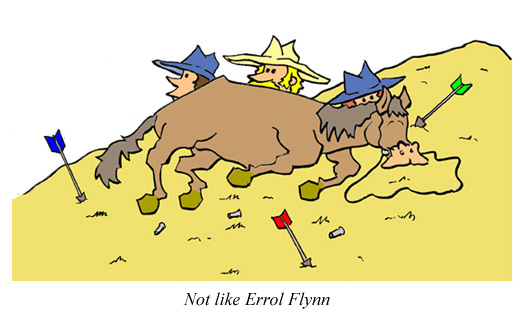
So by mid-afternoon on July 25, 1876, there was a rather curious situation along the Little Bighorn River. We have two military commands, separated by about three miles, each waiting for the other to show up. Around them are three to four times the number of angry, irritated Indians bent on destroying the men who were attacking their village. It's a perfect situation for a valiant Last Stand. But it's also a pretty good scenario for terrified men huddling together, running around like scared rabbits, and getting picked off like sitting ducks.
So how did the men fight? Again you can take your pick. Some historians have thought the men fought together as cohesive units and remained cool but were simply overwhelmed by numbers. Others talk about mass suicide (the save-the-last-bullet-for-yourself motif), men playing dead, and troopers throwing down their arms in absolute panic. From the Indian accounts, it seems like you had some of all of the above.
One thing to remember is that nothing that George, Marcus, and the rest did was necessarily wrong in itself. They were using the best tactics they knew. A couple of years before the Little Bighorn, the Army had issued a new manual of cavalry tactics written by Emory Upton (who actually beat George out for the commanding post at West Point). The officers at the Little Bighorn followed the procedures as well as conditions permitted. Dividing up commands was pretty common, particularly to trap an enemy in "pincer" movements (which may be what George intended). As far as Marcus halting the charge, it was definitely preferred that the men not fight on horseback. For maximum accuracy, they would dismount and form a skirmish line with the horse holders holding the horses. Non-coms (sergeants or corporals) would keep the men properly spaced since when under fire, soldiers tend to bunch together. Proper spacing was important since if the men were separated and an Indian missed the target by a foot or so, the bullet would pass between the soldiers. If the troopers crowded together, it might miss the intended target, true, but it would hit the man next to him.
That the soldier's bunched up was suggested in the 1980's after archeology located remaining cartridges and bullets that were left over from the battle. The skirmish lines that emerged showed the men were closer than the mandated five yard intervals. With the non-coms being picked off (perhaps deliberately), the men would instinctively crowd together making the Indian's job all the more easy.
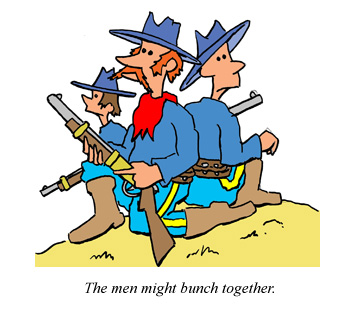
In contrast to the troopers, the Indians fought largely almost as individuals. If an Indian was fighting with a group of his friends and wanted to go somewhere else, that was fine. He could take a break or leave the battle entirely - the proverbial "run away to fight another day" philosophy. There was no such thing as desertion as far as the Indians were concerned although they might catch flack if they stayed away altogether.
That doesn't mean the Indians didn't fight together. They would sometimes remain in groups, but would adopt two tactics where a combination of coordination and independence were perfect for the fighting at the Little Bighorn.
First, Indians did fire their weapons from horseback but did not keep together in mounted formations. This kept the warriors well spaced and hard to hit. Next, the Indians, like the cavalry, would dismount to fight. But instead of forming nice, neat, and easily hit skirmish lines, they would stay out of sight and move in under cover. The Indians themselves were perplexed at the way the soldiers' fought. Why the heck did they get off their horses, line up at the top of a hill, and make themselves the easiest targets imaginable? One Indian said the soldiers must have drunk too much whiskey.
Who knows? Perhaps in some other situation troopers following Emory's manual might have had an edge. But here, because of the cavalry tactics, the Indian's method of fighting on the Little Bighorn's unique terrain, and last but not least because there were so many of them, the Indians were unbeatable.
The idea from the Hollywood movies is that the Indians swooped down in massed attacks, circling their enemy, whooping and hollering. The truth is a bit different. Yes, the Indians would make an occasional charge, but usually the fire was long range from 300 or so yards away. With their firearms obtained in trade and raiding parties - at least some had Henry repeaters and Winchester rifles - that wasn't too hard for the Indians who were good marksmen. The more covert warriors stayed in the gullies and ravines and snuck up keeping behind the hillocks and ridges (Sitting Bull, due to his age, mostly remained in camp). So the soldiers ended up trapped between steady long range fire and up close combat where the Indians would suddenly pop up, take a shot or two, and then disappear.
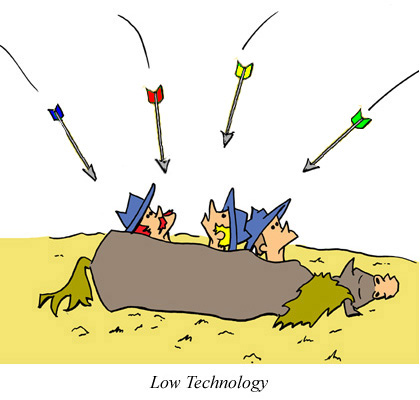
The soldiers themselves were armed with sidearm Colt revolvers, each with six shots but useful only to about 25 yards. Their rifles were Springfields, single shot carbines that were accurate but slow loading. It has also been reported that the copper headed cartridges often jammed in the rifles' chambers and sometimes tore off, requiring the soldiers to pry the empty bullets out of the guns with their knives. But more recently archeology has found that only a few percent of the cartridges had torn off, and defective bullets may not have been as serious a problem as is sometimes believed. Marcus himself said the failure rate was 6 %.
A number of Indians also had a weapon that was low tech and normally wouldn't hold a candle to a Springfield for range, but had surprising advantages, again due to the Little Bighorn's terrain. That was the bow and arrow. A skilled archer could (and did) literally shoot their arrows into the air, and they came down pretty much they knew where. There was no noise, no smoke, no muss no fuss. The usual tactic was to hide in a clump of bushes or in a ravine and loose the arrow into a high arc. A good archer could manage maybe six arrows a minute and place the arrow within a radius of a few yards. So the soldiers found themselves attacked literally from all sides - and even from above.
By looking at the pattern of bullets, cartridge cases and arrowheads, archeologist Richard Fox believes that the Indian tactics resulted in what is now called "tactical disintegration". This is the phrase now used to replace the older and more pejorative terms like "rout", "panic", or "[break] or go blind". But other historians disagree and believe the fighting was more disciplined, and the movement of the troopers was orderly. But the net result was the same.
George's companies probably began to collapse from the south with the troops under the command of Myles and James. Men based around Calhoun Hill were deployed down the slopes, but the Indians quickly whittled them down. Once more it helped (the Indians, at least) that the soldiers formed nice neat skirmish lines in full view of everyone, and the Indians stayed scattered and under cover.
James fell on the hill that bears his name, and Myles and his troopers began to move north toward George. At some point an onslaught of Indians on Custer Ridge wiped out most of the men with Myles, including Myles. The survivors either withdrew in an orderly fashion or ran in panic - that is, they were subject to "tactical disintegration" - to join George and the others.
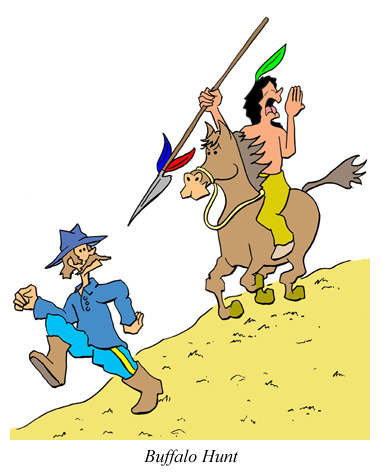
Eventually the remaining men - perhaps forty or fifty - were huddled together on the east side and just below the crest of the gentle rise now called Custer (or Last Stand) Hill. These included George, his brothers, Tom and Bos, and nephew Autie Reed, who by now must have been thinking if he ever got out of this mess his next vacation would be spent at Sarasota or Cancun. The horses were either dead or loose (some writers think the soldiers deliberately released their horses and hoped the Indians would go after them). The men took cover behind the dead animals, but by now the Indians were getting bolder and would charge toward the men. Out of 2000 warriors perhaps 40 had been killed and out of the total of 210 men in George's command, maybe 160 were dead. So by late afternoon, the odds were about 1760 to 40.
At some point, George was hit just below the heart. If he didn't die immediately, he certainly had to relinquish his command. Maybe that was the time some of the men broke away and tried to run toward the river. But as Marcus had found out, that was the worst thing a soldier could do. All were chased down as if (and these were the Indians' words) it was a buffalo hunt. Some of these troopers may have scrambled back to Custer Hill, which didn't do them any good.
The actual time George fought once his battle began in earnest has been debated. Estimates vary from twenty minutes to two hours, although these timings are not necessarily defining the start or finish of the Custer portion of the battle consistently. Recently, though, computer studies at the Naval Graduate School suggest a timing of 30 minutes. This, we should point out, is consistent with the short duration mentioned by the Indians.
To what degree there really was a Last Stand (or how many Last Stands there were) has also been hotly - and we mean hotly - debated. But almost everyone agrees it was not a Last Stand à la Errol Flynn. George was certainly not the last man standing - the odds alone make that unlikely. The Indians told how once the battle was over there were a few, but temporary survivors, and none of them were George.
Shopping Up
Once the actual battle was over, it was time for a bit of shopping. This was, in fact, a general tradition for the Indians who lived in a society where wealth (usually in horses and other accoutrements) were taken in raiding parties and battle. At the Little Bighorn there were a number of bargains - guns, cartridges, coats, boots, and of course, horses - all at cut rate prices.
Although you hear that Myles' horse, Comanche (now in the University of Kansas Museum), was the only survivor of Custer's command that's not quite true. First, a number of other horses were captured and taken by the Indians. Secondly, another cavalry horse named Nap survived, although Walt Disney never made a movie about him. Finally as we said, there were also some soldiers who were alive after the battle, if only briefly.

Traditionally it was the women and children who took over once the warriors were finished. They would strip the dead and also - in what many people find terrible - mutilate the corpses (the warriors did this as well). Mutilation could be subtle (a slash or two here; there, the odd scalp) or extreme (Tom Custer was hacked to ribbons and his head smashed literally flat as a pancake).
Despite the early twentieth century claims of a few old codgers that they were the sole survivors of Custers' Last Stand, no one who was with George after Private Martin rode away lived to tell the tale. One nearly made it, though. During the battle a mounted trooper made a break and started galloping off from the field. Some warriors took out after him, but soon the man looked back, pulled out his revolver, and shot himself in the head. The Indians thought it didn't make much sense because they were just about to give up the chase.
Another soldier made it all the way to the river and was hiding in the reeds until the wife of the Sioux leader Crow Dog, Woman-Who-Walks-With-The-Stars, saw him. She later said she felt sorry for him, realizing he probably had a wife and kids at home. But then she remembered the soldier and his friends had attacked her village and couldn't have cared less if the women and children were killed. So she picked up a stick and beat him severely about the head and shoulders until he sank beneath the water.
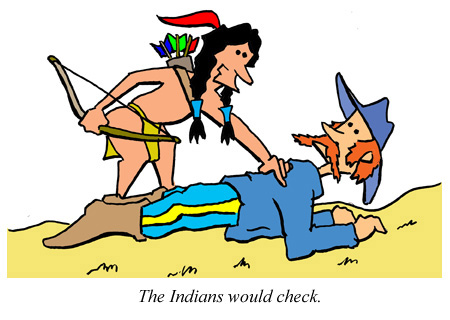
The ladies and kids found a few survivors on the field itself. If any of the wounded moved or groaned, they were dispatched in short order. Other troopers played dead hoping the Indians would pass them by. The Indians, though, were fairly conscientious in the mopping up and would check things out. Their diligence sometimes resulted in some funny scenes - or at least, the Indians thought they were funny.
Iron Hawk was fourteen years old at the time of the battle. He fought entirely with a bow, arrow, and war club and killed at least one soldier from horseback. When the fight was over, he and others were looking over the field. Suddenly he heard some people shouting and laughing. He looked over to see what was going on.
Two ladies had just finished stripping one the fallen troopers. In addition to taking the man's clothes, one of the ladies - to quote Iron Hawk - "started to cut off something he had." Iron Hawk didn't say what the "something" was, but you can bet it wasn't a St. Christopher's medal. The soldier, who was simply playing dead, took exception to handing over (figuratively speaking) such a souvenir and started fighting back. But then a third lady, knife in hand, ran up and settled the matter to the satisfaction of the majority of those present. But the sight of the soldier grappling with two old ladies sent the bystanders into peals of laughter. "It was funny," Iron Hawk said.
(Lest champions of the "other side" get huffy about such levity, they should remember an incident at the battle fought by Marcus and Frederick. At one point a trooper said he was going to hide behind a box of hardtack. Just as he lay down an Indian bullet smashed into the box, went all the way through, and hit the man in the head. All the soldiers who saw the episode broke out laughing).

After the last men in Custer's command were killed, the Indians returned their attention back to Marcus and Frederick. Through the rest of the afternoon and all the next day the Indians kept up the fight. As with George, most of it was long range sniping with an occasional charge which would inevitably be repulsed. But while the Indians were fighting George, Marcus and Frederick and their men had time to dig in. It was not a perfect defense by any means, but at least it was an organized perimeter. Ultimately Marcus and Frederick managed to keep the Indians at bay. Then toward the evening of the second day, June 26, 1876, the Indians got word more soldiers were coming. So they packed up and headed south.
The soldiers on their way were the men under Colonel John Gibbons. Alfred was with them as well, having continued along the Yellowstone after he left George. John, following the original plan, had ridden south up the river. John and his men moved onto the battlefield and began finding dead men everywhere. Then they continued on and finally came upon the survivors.
The first thing Marcus and Frederick asked was "Where is Custer?" John and Alfred said as far as they knew George and his men had been wiped out. They had found 197 bodies (there were actually 210) and no one alive.
Frederick didn't believe it. George had abandoned them, he said, just like he had Joel at the Washita. Alfred told him to go look for himself.
The troopers who were able spent the next two days burying the dead. The pleasantness of the task can be appreciated by reading forensic texts about dead people laying out for 48 to 72 hours in 90-plus degree weather (Mark Kellogg, was found where he fell on June 29, four days after he was killed, and it was only by his particular boots did someone recognize him.). With no adequate tools and the ground like flint they could only make what they called a respectful gesture. George was given the most complete burial, wrapped in canvas and placed in the same eighteen inch grave with his brother Tom. Rain and wild animals ended up playing havoc with the burials which in some cases were no more than brush pulled over the dead with a bit of dirt thrown on top. So the next year when some of the officers were removed for reburial - Custer at West Point; Tom at Fort Leavenworth - it was questionable whether and how much of any of the men were left.
Unlike many of the other soldiers who were horribly mutilated, George was lying as if asleep, although denuded of his fancy outfit and boots. There are at least two versions as to what Frederick said when he saw Custer on the field. One story was he simply said, "That surely is General Custer." The other account has Frederick bestowing on George a true Benteenean tribute. "There he is, God damn him! He will never fight anymore!"

Life After George
In early 1987 during the Iran-Iraq war, a US naval ship stationed in the Persia Gulf noted an Iraqi fighter in the distance. The ship radioed that it was American and so officially neutral. The fighter fired a rocket (before or after the message isn't clear), and the ship was hit. Thirty seven sailors were killed, and after an inquiry, the captain of the ship was relieved of duty and retired from the service.
Not long after the attack, another ship saw an Iraqi plane coming in. The captain held his fire, and the plane flew on. The captain said he just had a feeling the fighter would not fire and so deserved praise for his cool and level headed response.
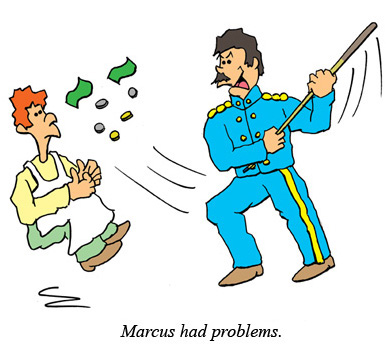
Although the connection between two modern naval engagements with the Little Bighorn may seem tenuous, it does show some facets of rendering historical judgment, particularly in military matters. Identical actions taken under nearly identical circumstances will not always produce the same results, and so the difference between brilliance and folly are often decided by actions of which the - quote - "hero" - unquote - has no control. But more to the point, if something goes wrong, someone will get blamed for something.
Assigning blame for the Little Bighorn began immediately. The first round, left by Alfred in a report written a week after the battle, went pretty squarely to George. Alfred's report was written in a moderate tone and was respectful to George, acknowledging that whatever mistakes he made he had paid the ultimate price. He then went on to details specific points where he believed George erred, and even today many historians echo his comments. A similar assessment was made by Lieutenant (later General) Edward Godfrey. Edward, of course, survived the stand with Marcus and Frederick. He gave a detailed review in an article written in 1892, and his criticism of George, although there, was pretty mild. He really trashed Marcus, though, something Alfred did not do.
First, George had ordered an attack on an enemy when he did not know its strength or exact location. He was outnumbered probably at least 3:1. True, George used the same tactics at the Washita, but even though it worked then, it doesn't mean it was a wise thing to do at either fight.
Next, George diluted his already thin command by subdividing his men further down - perhaps as many as five times. Division of command itself, Edward tells us, is not necessarily wrong. But soon George had his men separated into groups of as little as forty or fifty men. Since he had spread his divisions across four miles of terrain, the Indians could then concentrate their attacks on one group at a time. So the 3:1 disadvantage might end up being near 10:1 or worse for any given group.
Alfred also believed that by not adhering to the orders (sorry, "views"), George ultimately caused the fiasco. Although Alfred put his official words politely, at this point you get the sense that he was really irritated. Alfred said there was no indication that George tried to adhere to the original plan. He added that had George continued moving south rather than immediately following the Indian trail, then there would have been the coordinated joint action with John Gibbon. That, Alfred said, would have succeeded.
Although not specifically mentioned by Alfred or Edward, we have to add that George was not the great communicator. Certainly his taciturnity confused his top two officers. Promising support to Marcus but having his own definition of the phrase (or simply changing his mind) led Marcus to believe something had gone wrong. So Marcus stopped his charge and waited for George. Similarly, George's orders to Frederick to "be quick" and "bring pacs [sic]" were terse and seemed contradictory. With Marcus going on about how he was waiting for George's support, Frederick believed (or could rationalize) that staying with Marcus was what George wanted.
Naturally George's friends take exception to such criticism. First they say Terry's orders were unrealistic to begin with. Planning a coordinated action when John and George started from such distant points, had to ride for several days, and then were expected to meet before attacking the village was ridiculous (even Edward didn't think it was possible). George was on his on own, and he knew it. Once some of the Indians spotted the soldiers, George had to attack, as any competent officer would have done.
George's friends also state emphatically that he was indeed let down by his subordinates. Although a besotted wuss like Marcus couldn't have been expected to help, the able and competent Frederick should have tried to connect with George. Chain of command technicalities or not, George wanted Frederick to "be quick" and "bring pacs [sic]", and Frederick knew it. With prompt action and guided by the sound of gunfire (a military maxim is to move toward the sound of the action), Frederick could have reached Custer. Frederick's extra troops would have helped keep the Indians at bay and let everyone get back to Marcus.
Not at all, Frederick's friends counter, George was to blame and for reasons that go back way before the Little Bighorn. His most singular failing was he was never able to command wide loyalty among his men or officers - something a good officer always does. Frederick sincerely believed George was the type of commander who would abandon his own men if things got tough. Why should Frederick risk his life and those of his men when for all he knew George had ridden off and was having breakfast outside of a cozy tent with Alfred while he, Marcus, and the rest were eating dirt while Indian bullets whizzed overhead? George was just a bad officer.
"Bad officer?" splutter George's champions. Why, that's patently absurd! After all, when George first sent men down to the river, he could very well have been intending to draw the Indians away from Marcus. As we know, that worked all too well. George may have died because he was doing what he could to protect his men, including Marcus. George was a fine officer and an experience Indian fighter.
"Experience Indian fighter?" hoot Marcus and Frederick's friends. Other than a couple of skirmishes, the only other time George really fought Indians was at so-called Battle of the Washita. At the Little Bighorn he was just trying to recapture his glory days of nearly a decade previously. Bad tactics that worked in 1868 were the same bad tactics that failed in 1876.
Why you historical ignoramuses, scream George's supporters. Marcus and Frederick were the biggest dumbsocks that ever the Indian Wars saw! Why, if it hadn't been for their bungling ...
Oh, well, enough said.
The Battle of the Little Bighorn - originally styled as "Custer's Last Stand" - was also the last stand of the Indians as a nomadic people. When news hit the East about Custer's demise, there was no more of that "noble savage" nonsense. Plans were soon drawn up to destroy the reservations and break up the tribes. Three years after the Little Bighorn selected Indian children began to be removed from the reservations and sent to the Carilse Indian Industrial School. Other Indian schools were established and followed suit. Forbidden to speak their native language or retain any vestiges of their culture, they received a - quote - "proper" - unquote education. Although some graduates went on to become doctors, lawyers, and - like Jim Thorpe - world class athletes, for others the years at Carlisle did them little good once they got back home.
The government also decided it would no longer deal with the tribes as independent nations. In 1887, Congress passed the Dawes Act which destroyed the tribes as independent organizations. The basic philosophy was to stop the policy of assigning tribal lands, but instead to give each Indian family a 160 acre homestead. Land left over was eligible for white settlement (arguably the real reason for the act). Some tribal lands remained, reduced in size, and beginning in 1934 some of the confiscated lands were returned to tribal jurisdiction. Still, as early as the mid-twentieth century, parts of Indian lands were still being appropriated by the government.
But first things first. Sitting Bull, and the Indians the defeated Custer needed to be caught. So General Sherman sent out Colonel Nelson Miles to finish what George had started but had not been able to complete.
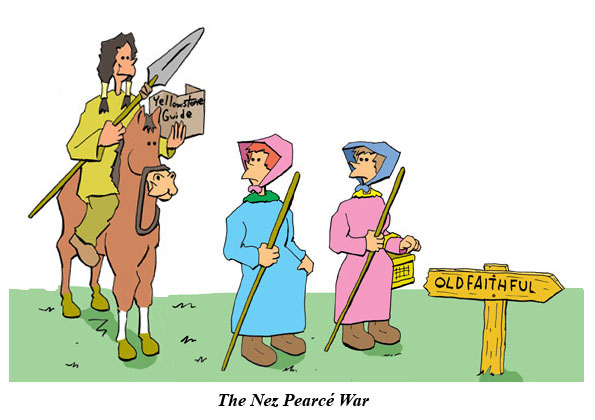
Nelson was a friend of George, but seems to have been the type that focused more on getting the job done without having an eye for glory. He waged a sustained campaign in the winter of 1877 and drove Sitting Bull and his band to Canada. Although the Indians were allowed to live as they wanted in the Land of the Northern Lights (there was, after all, plenty of room in Western Canada), the buffalo herds were almost gone, and the harshness of Canadian winters drove them back to the US. Sitting Bull ultimately surrendered and settled at the Standing Rock Reservation. But Indian warfare continued with the Nez Pearcé War of Chief Joseph who at one time actually captured (but did not harm) some tourists at the new national park, Yellowstone. Then there was the Ghost Dance resistance, a movement which ultimately resulted in Sitting Bull's death while being arrested by Indian policemen. The Ghost Dance ended in 1890 at Wounded Knee, which, we hear, marked the last of the Indian Wars.
Indian Wars, perhaps, but not Indian Resistance. That has continued even into the twenty first century. Tactics, though, have changed, such as in 2007 when Russell Means (best known to modern audiences as the chief in Walt Disney's Pochohantas) and his friends declared "The Republic of Lakota" on land traditionally owned by the Sioux. It is not, they hasten to add, a declaration of independence, but instead a declaration of sovereignty. This is a subtlety lost on the average statesman and recognition by foreign powers has been a bit slow. Vladimir Putin, Russia's prime minister, ticked off that the United States recognized Kosovo, has implied he might.
For several years after George's death, times were hard for Libbie. With no real livelihood, she had to rely on interest from their investments and George's life insurance. But when historians began to take interest in George, she found herself and her memories in demand. She helped the historians out if they liked her husband, and the books they published gave her some much needed income. She also wrote three books of her own which actually did pretty well and are worth reading. Historically they are primary source material but naturally tend to make George look good. Libbie never remarried and lived long enough to be captured on motion picture film. She died in 1933, nearly 91 years old.
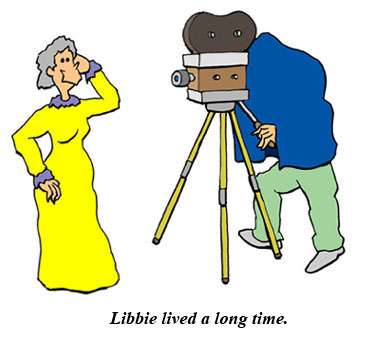
Frederick Benteen remained in the service and continued fighting Indians. He visited the Little Bighorn on the tenth anniversary of the battle with a number of Indian participants also present.
Remaining cantankerous as ever, in 1887 Frederick was suspended from rank and duties at half pay for one year for drunkenness. However, there is room to doubt the testimony of the witnesses, and the whole affair may have been more due to Frederick's clashes with the military bureaucracy than his tippling. In 1888 and his suspension over, he retired. Officially his resignation was voluntary and due to medical problems related to his service. He died ten years later.
For the rest of his life, Marcus, a man with few friends then or now, remained bitter about the Little Bighorn. His problems really began when the first pro-Custer / anti-Reno book was published by Frederick Whittaker just a few months after the battle. Soon the newspapers splashed the story of how Marcus was the coward who sent George Custer and 209 men to their deaths. After a couple of years of increasingly bad publicity, Marcus insisted on an official inquiry. The board (which was not a court-martial) convened in Chicago in January, 1879 and released its findings in March. Reno, they said, was not guilty of wrongdoing or cowardice.
"Whitewash!" shouted Whittaker and Libby (and a lot of others since). Most of the testimony was from survivors under Marcus's command, and so George's friends felt testimony was way slanted toward the major. Besides, the soldiers would naturally be reluctant to testify against a superior officer. There's some support for such a claim since at the inquiry Edward Godfrey testified that while Marcus was "excited", it wasn't more than anyone else would have been. Nor, Edward said, did Marcus show signs of cowardice. But in his 1892 article and after Marcus was dead, Edward really trashed the former major, insinuating that as long as Marcus was in charge, any attempt at helping Custer would have failed.
At least George's friends had some crumb of comfort in that the testimony and findings were no means adulatory. Some men testified they saw Marcus drinking during the fight (some admitted they took a nip, too). Others would tell how Marcus spent much of his time hiding behind boxes while Frederick walked up and down the line encouraging the men. In the end, the officers of the court did not hand Marcus any ringing endorsements despite their technical exoneration. He may not have been guilty of cowardice, they said, but Marcus did not particularly distinguish himself, and a number of other officers had clearly done more to promote the protection of the men.
It would have been nice to report that afterwards, Marcus picked himself up and finished with a distinguished military career. After all, by 1890 the United States officially declared the frontier was dead and gone, and so turned its attention (and its army) overseas. Many career Indian War soldiers such as Nelson Miles served as late as the Spanish American War. Others served in the so-called Phillipine Insurrection and even later. One young lieutenant, Hugh Scott, was with Marcus and Frederick beginning in 1877 and was sent out that year to the Little Bighorn to help rebury the soldiers. Hugh rose to become Chief of Staff of the Army from 1914 until 1917. Then of course there was "Black Jack" Pershing who commanded the American Expeditionary Force in the First World War. Many people know he had been sent out earlier to fight Pancho Villa in 1916, but few know he was at Wounded Knee.
Marcus never made it that far even though with George gone, he was now highest ranking officer of the 7th (excluding Colonel Sturgis who was still away). Now you can question how severe was Marcus's problem with booze prior to the Little Bighorn, but it certainly looks like he picked it up afterwards. The following August his whiskey purchases with the sutlers averaged half a gallon a day. Naturally, this tended to affect his dealings with his colleagues.
In the September following the Little Bighorn, and the first night back at Fort Lincoln, Marcus and the other officers went to the Officer's Club. Fueled by liquor the conversation got rowdy (Colonel Samuel Sturgis called it a debauch). At one point a lieutenant from the infantry, John Manley, made a remark about a letter in the Chicago Tribune written by Confederate General (and George's roommate at West Point) Thomas Rosser. Rosser had criticized Marcus for stopping his charge, and Marcus interpreted John's words as agreeing with Rosser. Hard words passed, and the two men ended up engaged in fisticuffs, rolling on the floor amidst the spilled spittoons. Although at the time nothing was done, it foreshadowed things to come.
Marcus's high jinks at the Officer's Club might be dismissed as an understandable overreaction fueled by alcohol after a trying time in the field. But Marcus also shared his fondness for the spirits with a hankering for the opposite sex. Nothing wrong with this in principle, of course, and it certainly wasn't atypical of the soldiers in the frontier garrisons (or anywhere for that matter). But unfortunately, Marcus didn't seem to have much of what women want, and he certainly had a way of pushing forth what he did have in a manner that that did not (and does not) sit well either with the ladies or with the military courts.
As winter set in, the Seventh Cavalry was dispatched to several different forts to relieve the crowding typical in the off season. Marcus went to Fort Abercrombie where he was happy to find himself the commanding officer.
One of Marcus's fellow officers was Captain James Bell. James was thirty-nine, and he had married a woman named Emily who was twenty-six. Emily was pretty and vivacious, and Marcus seemed to have taken a shine to her, particularly when Captain Bell was away.
Now it was common - and quite proper - for a soldier at a frontier garrison to escort another man's wife to various functions or even to take them for buggy rides in the country. The custom was perfectly commonsensical in a day when women weren't supposed to go about by themselves, and their husbands were frequently away on duty. A soldier could also make social visits with a married lady and do so without censure. But everything was expected to be on the up and up with no hanky-panky involved.

So at one point Marcus decided to pay a call on the pretty Mrs. Bell. When he knocked on the door, he was greeted by Emily - and to his surprise - a young lieutenant named Herbert Slocum who had been "reading" with her. Herbert soon left, and Marcus stayed to chat - for two hours. Before he left and no doubt telling her how Custer had promised to support him, Marcus "attempted to draw her person close to his own" and moved his hand up her arm. Emily somewhat archly asked the major if that was the Masonic grip. Marcus laughed the comment off and left.
Evidently Marcus thought he had impressed Emily with his savoir faire. A short time later, the sister of Lieutenant W. W. Robinson, who had been visiting her brother, was about to leave for home. Everyone was going to say good-by to the young lady, and Marcus, probably without an invitation, stopped by Emily's house to be her escort. Later Marcus walked Emily home. Then as she was stepping through a screen door, Marcus - again we hear - "placed his arms about her waist" in what he no doubt considered courteous assistance. This time Emily made no bones about the major's handling (no pun intended) of her difficulty and told him flat out not to do that again. Marcus said there wasn't any harm in it and again left.
It's hard to understand what Marcus was thinking. Even today laying hands on a fellow officer's wife is a pretty serious military offense (and it's not too smart for civilians either). Maybe Marcus thought Emily was just playing hard to get. For her part Emily decided she would have nothing more to do with the randy major of the Seventh. But soon her (understandable) decision and the dictates of nineteenth century military protocol brought things to a head.
Christmastime at Western forts was always welcome. Special dinners were held for the enlisted men, and the officers also made the rounds of the various festivities. Emily decided to throw a party, and she asked all the officers and their wives over - all the officers, of course, except Marcus. Protocol, though, dictated the highest ranking officer should be invited to all functions. Now Marcus did get the message. So with the other officers and their ladies reveling in the Christmas spirit, Marcus retired to the officers' club, started drinking, and told the fort sutler that Mrs. Bell had thrown down the gauntlet. "This means war," he declared.
Religious services were held every Sunday, and usually civilian ministers were invited to preach. One of the regular pastors was a friend of the Bells, an Episcopalian minister named Richard Wainwright. Naturally Reverend Wainwright was going to stay at the Bell residence, as he had a standing invitation to do so even if the Captain was away. Again such an arrangement on the frontier where housing was at a premium was nothing unusual.
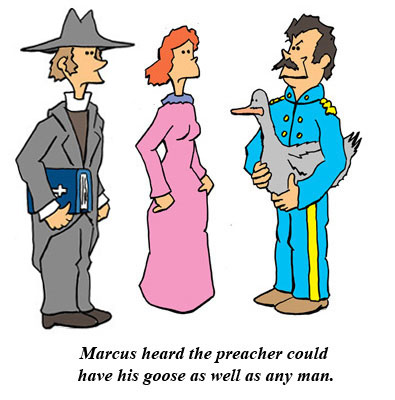
Marcus may have stopped his attack at the Little Bighorn, but he certainly could keep up his fight with Emily. Soon he took the Reverend aside and told him that his staying with a woman as notorious as Mrs. Bell was causing men to talk. He should move to other accommodations. Mind you, it was the preacher's good name he was concerned about, Marcus said. After all, Mrs. Bell's character was like a rotten egg, nothing you could say could hurt it. But now the officers were beginning to make ribald jokes about the preacher himself. Why, one of them even said that the preacher could have his goose as well as any man and he could have it with Mrs. Bell.
Reverend Wainwright didn't want to do anything that might give credence to any rumors, and so he just told Marcus he'd think about it. Well, Marcus said, if the Reverend remained with Mrs. Bell, he could not permit him to officiate at any services. Reluctantly, the Reverend agreed to change quarters. Marcus said fine, now Reverend Wainwright could preach. But in a rather unintentionally humorous double entendre, Marcus added he could not allow Mrs. Bell to "play the organ" when the Reverend was in the pulpit. When the service was held it was without Emily's music.
Well, when Captain Bell got back to Fort Abercrombie, Emily gave him an earful. Bell immediately filed charges against Marcus for conduct unbecoming for an officer and which were "to the scandal and disgrace of the service." Attempts at mediation were initiated by Colonel Sturgis but failed. So Marcus was called in for court-martial and found guilty.
With the charges affirmed and the "to the scandal and disgrace of the service" tacked on to the verdict, the court had no discretionary power. So they ordered Marcus out of the army. But President Hayes felt that Marcus's war record merited leniency, and he reduced the sentence to suspension from rank and pay for two years. The inquiry about the Little Bighorn was held just before he got back.
In 1879 and his suspension over, Marcus was back with the Seventh Calvary, officially exonerated for his actions at the Little Bighorn and having paid his debt to military justice for having hit up on Emily. Stationed at Fort Meade (now a small community in South Dakota), Marcus was no longer in charge and instead was serving with his old boss, Colonel Sturgis.
It would be nice to think Marcus had finally learned to control both his bottle and his hormones. But since by now you know Marcus, you also know there was no such luck.
Once he was back Marcus began to notice Colonel Sturgis's pretty daughter, Ella. Although she was courteous enough to the major, the twenty-year old beauty didn't find much of interest in a forty-five year old and increasingly pudgy major. Nor did her pappy think much of Ella's would-be suitor (the fact that Samuel's son, James, had been killed at the Little Bighorn may have tempered his feelings toward Marcus). Samuel didn't even want the major around. Marcus once showed up to visit Ella and her mom when the colonel was away on a buggy ride. When Samuel got back and learned Marcus paid a call on the ladies, he was quite miffed. If he had been there, he said, he wouldn't have even let Marcus in the house. But worse was to come.
As usual to pass away the time, Marcus and the other officers would go into town to shoot some pool and (of course) have a few drinks. There Marcus (so we hear) got drunk, tossed a chair through a window, threatened to fight over a bet, and knocked some coins out of the proprietor's hand. But Marcus even caused problems when he was trying to behave. Once he went over to a fellow officer's house for dinner and drank so much that the hostess thought he was going to throw up.
Marcus was again called up for court-martial for disorderly conduct, which even included the charge that he drank too much at dinner. So now he was officially under arrest until his trial, and his responsibilities and day to day activities were restricted. He was not even allowed to approach his commanding officer's quarters without permission.
Well, leave it to Marcus. In November he walked up to the Colonel's house and peeped in the window at Ella as she sat sat reading in the parlor. He even rapped on the window to get her attention.
Ella completely freaked out. Or as her parents put it, she became so "affrighted" they feared she would be taken with a form of "St. Vitus' dance." Ella even said that knowing her dad and Marcus were not on good terms, she was afraid the major might have come to kill her.
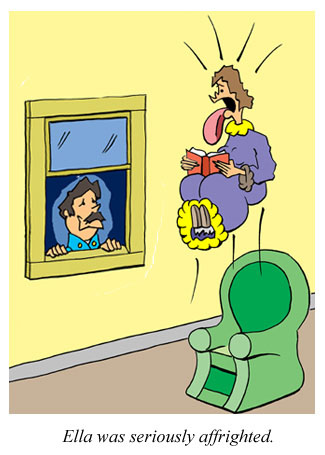
Samuel, not wanting to leave his wife and Ella alone when Marcus was prowling about, sent his next door neighbor and adjutant, Lieutenant Ernest Garlington, to find Marcus. Ernest found the major had returned to his own quarters, but had gotten quite indignant when questioned about peeping at Ella. Or at least Ernest told Samuel that Marcus gave no explanation for his conduct. So in addition to raising the ruckus by tossing the chair and the other stuff, Marcus now had the additional charge added of being a Peeping Tom tacked on to the list.
For some reason, Marcus wasn't worried. He knew he could explain his conduct to the satisfaction of everyone. Ella? He was just admiring her. Drinking too much at dinner? He had come in from the cold, and the warmth of the house had made him drowsy. Tossing a chair and knocking coins out of a bartender's hand? Boys will be boys. He didn't even bother to retain counsel.
Proving the old adage about a man who acts as his own attorney, Marcus was convicted. Again due to the technical reading of the finding, the only option for the court was dismissal from the service. The officers, though, agreed with Marcus that his offenses were not severe enough for such extreme action.
Instead, they recommended suspension from rank and pay for one year. But they hit a snag when the report was referred for final review to Major Henry Goodfellow of the Bureau of Military Justice. Henry pointed out that Marcus had a recent conviction for charges of similar severity. He had received a reduced penalty then as well. Were they to continue to grant leniency to an officer of over twenty years service in an army that had no hesitation in dismissing wayward cadets from West Point? Although Henry did not insist Reno be dismissed, his review persuaded Secretary of War Alexander Ramsey that enough was enough. Alexander said there should be no clemency. President Hayes agreed, and Marcus was out of the army for good.
Marcus spent the rest of his life trying to get reinstated. Everything he tried, including Congressional action, failed. In 1889 he died of pneumonia arising from an operation to remove a cancerous growth on his tongue. It was April Fools' and nine years to the day after Marcus was dismissed from the service. Finally in 1967, a military board reviewed his court martial record and decided the sentence had, indeed, been too harsh. So Marcus was given a belated honorable discharge and reburied in the military cemetery at the Little Bighorn.
The Battle of the Little Bighorn rages on today as controversial now as ever. In 1991, the park, then called the Custer Battlefield, was renamed the Little Bighorn Battle National Monument, acknowledging obliquely that there were two groups of Americans fighting each other that day. On July 25, 2003, a memorial was dedicated to the Indians who fought and died at the battle. Honoring the Indians sometimes miffs the traditionalists who still see the cavalry as the good guys and the Indians as the bad guys. Well, that's the way George thought, too.

References
There is certainly no dearth of books, articles, or websites on George Custer and the Battle of the Little Bighorn. In this day of on-line used book services, obtaining once rare volumes is surprisingly easy and also much useful material is available online. The official verbatim dispatches of the campaign were assembled in a book form and make most interesting reading. The complete Reno Court of Inquiry (again it was not a court martial) is also available (although not in a physically high quality volume). Books and articles by participants (particularly Edward Godfrey, Charles Windolph, and other soldiers) have been published. Even better, the individual soldier and Indian accounts have been assembled on the web by Bruce Brown in a very readable format.
A Terrible Glory: Custer and the Little Bighorn - The Last Great Battle of the American West, James Donovan, Little Brown and Company (2008). The most recent book about the Little Bighorn. There is a fair amount of background material but mostly this book focuses on the actual battle. Although some reviewers think the book is a bit too laudatory toward George and too hard on Marcus, certainly it's not much different than other post-Vietnam era books about the subject. Since it's well documented and foot-noted, you can check out the sources yourself. James pretty much seems to believe the average participant told things as he saw them. Very readable, and the action flows smoothly and chronologically. Good maps and clear explanations of the action leading to, during, and after the battle. Maps where north is up and south is down are very welcome given how other LBH books sometimes tilt the directions this way and that. Although there's some controversial material (for instance, that the Crow scout Curly wasn't with George), this is a good introductory book. Once more the lesson here is that anyone writing about the Little Bighorn has to toss somebody's story out.
This book gives extra detail that you don't find in other books. For instance, from a lot of writings you guess Marcus drank too much, but it's not clear how much was rumor or innuendo from his enemies. From mass balance analysis it's likely he drank a bit less than a pint at the Little Bighorn (unless he had a humongous hip flask), but James points out that in a 22 day period right after the battle, Marcus purchased 11 gallons of whiskey. Yes, people drank much more in those days - a moderate drinker then would be a boozer now - but half a gallon of hard liquor a day inevitably affects one's personality. Marcus's friends will point out that the extent of Marcus's drinking is speculative, and his accusers often had an axe to grind. This is true, but at the same time few problem drinkers leave documented records of their imbibing, and Marcus's problems are much more intelligible if he was regularly and heavily hitting the sauce.
The Little Bighorn, 1876 : The Official Communications, Documents and Reports with Rosters of the Officers and Troops of the Campaign, Lloyd J. Overfield, University of Nebraska Press, (1990). Great reference source. Verbatim unedited reports of the Little Bighorn Campaign. This has the earliest reports written within a day after the battle. It also includes the company muster rolls and how the soldiers fared. When you read the dispatches you get the feeling everyone thought this would practically be an outing until you come to Reno's report written from the field. Then when you get to the muster rolls, it's actually a bit sobering seeing all the "Killed" annotations for the companies that rode with Custer.
A Complete Life of General George A. Custer, Major-General of Volunteers, Brevet Major-General U.S. Army, and Lieutenant-Colonel Seventh U.S. Cavalry, Two Volumes, Frederick Whittaker, Sheldon and Company (1876), Reprint: University of Nebraska Press, (1993). With a title like this, you know this is the book that started it all. George Custer, we learn, could do no wrong and was betrayed by knaves, charlatans, and cowards like Marcus Reno and Frederick Benteen. Needless to say, Frederick and Marcus did not like this book.
Glory-Hunter A Life Of General Custer, Frederick F. Van de Water, Bobbs-Merrill Company, (1934), Reprint, University of Nebraska Press, (1988). The first "revisionist" history of George. Anyway, this is a classic biography that says George was not a saint. Naturally early books don't have the advantage of incorporating the archeological work of Richard Fox and colleagues, but they are useful in finding the sources of stories that may not be true but have become part of the legend. For instance, here you can read the dichotomous versions of the story where George learns of Frederick's letter about the Washita. The accounts, the author said, are "garbled".
Cavalier in Buckskin: George Armstrong Custer and the Western Military Frontier, Robert M. Utley, University of Oklahoma Press, (1988). This has become a classic introduction to Custer. Robert would have to be called a bit pro-Custer. He also admits his account of the battle "may" be what happened.
Custer: The Controversial Life of George Armstrong Custer, Jeffrey Wert, Simon and Schuster (1996). A biography of George from a mainstream publisher, pretty objective, with no preconceived notion of putting blame on any particular character. A good book to read about George's early years before the Little Bighorn.
Lakota Noon, Gregory F. Michno, (Mountain Press Publishing, 1997). A time-study where a number of Indian accounts are reported side-by-side within specific time intervals. There's considerable background information, including a very reasonable presentation on how the size of the village and the number of warriors was not as great as many earlier reports claimed. The maps - many from the original Indian interviews - are a bit confusing as "North" is not always up but moves around.
Gregory discusses the testimony of White Cow Bull who claimed he shot a buckskin clad soldier at the ford of Medicine Tail Coulee. Although some authors accept this as strong evidence Custer was killed or seriously wounded attempting to cross the river, Gregory thinks White Cow Bull's testimony is contradicted by too many others witnesses who maintain that the soldiers did not get into the water. Instead, some of the Indians say they had crossed the river themselves and were engaging the soldiers from the East bank, not the village. If that's true White Cow Bull's story cannot be true.
Custer's Fall: The Indian Side of the Story, David Humphreys Miller, University of Nebraska Press, 1985. Another compilation of the Indian's stories, not verbatim accounts, though. David was an early collector of the Indian accounts and an excellent artist.
Archeology, History, and Custer's Last Battle Richard Allan Fox, University of Oklahoma Press (1993). Great book even if you don't agree with Richard's conclusions about tactical disintegration and that the soldiers resisted very little. There are plots of cartridge cases, bullets, and arrowheads that do in fact seem to show skirmish lines bunching together. At the same time you wonder since there are not too many artifacts over a given area are we possibly seeing simply spurious patterns caused by chance. You can create similar patterns by generating limited points randomized in Cartesian coordinates. But are the observed patterns observed on the field really and statistically different from random? An interesting problem for a statistician.
They Died With Custer: Soldiers' Bones From The Battle Of The Little Bighorn, Douglas Scott, Patrick Willey, and Melissa Connor, University Of Oklahoma Press (1998). A good book for the Little Bighorn fan interested in forensic anthropology.
Custer's Last Campaign: Mitch Boyer and the Little Bighorn Reconstructed, John Gray, University of Nebraska Press (1991). This seems to be the first "time study" of the Little Bighorn and sometimes whittles who-got-where to the nearest half minute. However, there is no validation or variability in the methodology, and so we wonder if in the end all we can say is Frederick Benteen arrived at Reno Hill, say, at 4:30:30 p.m. - plus or minus thirty minutes.
Part of the interest in this book is that it told of the finding of the skull fragment believed which may be Mitch Boyer, the scout who told the young Crow Indian, Curley, to leave since they were all going to be killed. Certainly the skull image does seem to fit the photograph of Mitch pretty well. At the same time similar fittings have been shown to be spurious. Sometimes you get a good physical fit, but then the DNA of the bones and that of relatives of the reported soldier don't match. But the opinion seems to be that the bones thought to be Mitch's are in fact Mitch.
The Court-Martial of General George Armstrong Custer, Lawrence. A. Frost, University of Oklahoma Press, 1968. Not to be confused with The Court-Martial of George Armstrong Custer by Douglas Jones. The latter is a fiction book about what would have happened if Custer had survived the Little Bighorn (which has George being acquitted and going nuts). The book by Lawrence is the real McCoy. It's about George really being court-martialed for going absent without leave and conduct prejudicial to the order of the military - essentially abusing his position of authority. He was found guilty and suspended for a year without rank or pay.
Reno Court of Inquiry: Proceedings of a Court of Inquiry in the Case of Major Marcus A. Reno. Concerning His Conduct at the Battle of the Little Bighorn River on June 25-26, 1876, Ron Nichols , Custer Battlefield Historical and Museum Association, (1996). The court of inquiry transcript. Lots to read, and very interesting to see all the different viewpoints. As of this writing copies are available from online books sellers, but tend to be a bit pricey. There is, though, a .pdf file of the original government printing online (see below). Ron, by the way, wrote a good biography of Marcus (also below).
The Custer Myth: A Source Book of Custerania, written and compiled by Colonel W.A. Graham, The Stackpole Company (1953). A classic book for Custerphiles and phobes alike.
In Custer's Shadow: Major Marcus Reno Ronald Nichols, Old Army Press (1999), University of Oklahoma Press (2000). Great book about Marcus Reno with complete information on Marcus's later trials and tribulations with the ladies. Also tells the story of Marcus's belated reinstatement in the Army and his internment with his men at the Little Bighorn military cemetery.
Harvest of Barren Regrets: The Army Career of Frederick William Benteen 1834-1898, Charles K. Mills Arthur H. Clark Company (1985). Good, complete life of Frederick. For years, copies of this rare volume were not cheap. However, in 2011, the University of Nebraska Press issued a paperback edition at a far more modern price..
A good short biography of Frederick, "Frederick W. Benteen", by Steven Leonard appeared Wild West magazine in June 2001. Happily, it is on line at http://www.historynet.com/frederick-w-benteen.htm.
I Go With Custer: The Life and Death of Reporter Mark Kellogg , Sandy Barnard, Bismarck Tribune (1996). Nice biography of Mark Kellogg with details of how the (most probable) location of his body was found. Actually Mark doesn't seem to have had much of a flamboyant personality, but the book is still a must read for Custer and Little Bighorn buffs.
A Summer in the Plains with Custer's 7th Cavalry: The 1870 Diary of Annie Gibson Roberts, Brian Pohanka (Editor), Schroeder Publisher (2004). Annie's uncle was Major George Gibson, and in 1870, she went visit him at Fort Hays, Kansas where she met all of the major players of the Seventh Cavalry. This book paints a crisp picture of the life in the post-bellum cavalry, and it comes off as fairly genteel, at least for Annie. There is, though, an undercurrent of robustness that makes you believe Annie was not a fragile stereotypical Victorian-day damsel. Interesting details of social life in a day before television, video games, E-mail, cell phones, and text messaging. Instead you had to make do with reading, conversation, self-made music in the parlor, and buggy rides. You might suspect - correctly - that Annie had no dearth of attention and social calls from the soldiers. In fact, one's of the officer's attentions proved too much to resist, and she ended up marrying Captain George Yates in a lamentably brief marriage.
Washita: The U. S. Army and the Southern Cheyennes, 1867-1869, Jerome A. Greene. University of Oklahoma Press, Campaigns and Commanders Series, (2004). The most recent book on the Battle (or Massacre) of the Washita. Like the Little Bighorn, the Washita still elicits fractious argument a century and a half afterwards. There is no doubt that Indian raids had killed settlers - often under horrific circumstances - so not all Indians simply sat in their village and rode off to hunt buffalo. But the government did not distinguish between the actual perpetrators and those that had nothing to do with the raids. The Washita came about largely due to a technical problem with who was supposed to surrender and to whom. Black Kettle and his band tried to give up and were told, sorry, they couldn't, and so they went back and set up their villages along the Washita. Of course, it didn't help that the military in general didn't care if Indians got killed or not.
George evidently was also set some precedence in reporting extremely inflated body counts. At one time George claimed 300 warriors killed and about fifty women and children captured. The Indians, though, claimed maybe three dozen warriors killed, and Jerome estimates maybe it was a couple of dozen. The numbers, though, still don't add up. The village had 51 lodges. So on the average we have one woman and one child per teepee? It seems that either the village was smaller than George said (a possibility) or a lot more women and children were killed (very likely), or the male/female ratio among the Indians was about 6:1.
But whether you call it a battle or a massacre, the tactics were those used by the Army during the Indian Wars. You sent troops in the village in a surprise attack, shot as many warriors as possible, took women and children hostage to force whoever got away to return to the reservations. As at the Little Bighorn, the attitude of killing women and children at best can be characterized as indifference. At the Washita Custer was watching the battle from a hill, and a group of soldiers were pursuing and firing into a band of women and children. George did nothing until scout Ben Clarke asked him if he was going to permit that. George said, no, and told Ben to ride down to the officer and tell him, with his compliments (George's words), to stop it.
Washita Memories: Eyewitness Views of Custer's Attack on Black Kettle's Village Richard Hardorff, University of Oklahoma Press (2006). Great book of - as it states - accounts by people who were actually at the Battle - or Massacre - of the Washita. Useful for Little Bighorn buffs as it also has the letter Frederick Benteen wrote that so raised George's ire.
Historical Analysis of the Battle of the Little Bighorn Utilizing the Join Conflict and Tactical Simulation (JACTS), Michael Charlebois and Keith E. Pecha, Thesis of the Post Navy Graduate School, Monterey California, June 2004. Michael and Keith took weapons peformance data and plugged it into the computer program the military uses to analyze tactics. Interesting approach but you have to be careful and not let the computer overshadow human judgement (the computer predicted some Indians were still being killed after all the soldiers were dead). Still the computer helps sort out which battle scenario is most likely. The final Custer phase of the fight was also predicted to be quite short - perhaps half an hour which (in CooperToons' opinion) fits with the Indian testimony quite well.
Encyclopedia of Frontier Biography Dan Thrapp, University of Nebraska, Two Volumes (1991). A who's who of who was what and when.
4. "The Old West" (Time-Life, Inc, 1975). True scholars will heap ridicule and abuse for including this series and these volumes as actual references. Yes, errors creep in (such as when the volume "The Cowboys" tells us how the nineteenth century cowboys sang "There's an Empty Cot in the Bunkhouse Tonight" which was written by Gene Autry in 1943), but this series has been extremely popular and many western buffs have copies.
The volumes with information on the Little Bighorn are:
"The Women", Joan Swallow Reiter. Has the story of Reno's problems with the ladies.
"The Soldiers", David Nevin. The last chapter is about Custer's Last Stand.
"The Indians", Benjamin Capps. Ditto.
"The Great Chiefs", Benjamin Capps. Ditto.
Internet Resources
"Wyoming Tales and Trails", http://www.wyomingtalesandtrails.com/. Good and detailed story of the Indian Wars and the specifics of the Little Bighorn is at http://www.wyomingtalesandtrails.com/custer.html. Lots of pictures. Generally this has a moderate tone but overall faults Custer. It points out that ironically had Reno attacked and been wiped out, people would be debating whether Custer could have saved Reno.
There are also informative and balanced discussions about the various men who over the years claim to have been the last survivor of Custer's command. A CooperToons personal opinion is none of the claims have any validity.
"Conversations with Crazy Horse Source Material", Bruce Brown. An excellent and extensive selection of both white and Indian accounts. URL: http://www.astonisher.com/ particularly at http://www.astonisher.com/archives/museum/index_full.html. The first hand accounts Bruce has posted are indispensable for the true student. There's so much information you can go back to this site time and again and learn something new.
Bruce gives a detailed explanation for the case that White Cow Bull killed Custer at the ford (but see comments in the reference for Lakota Noon above). Another non-mainstream opinion given is that historians should accept the account of Reno's solider, Peter Thompson. Bruce makes some good arguments that Peter's story is far more credible than previously believed (actually, the main, although not totally satisfying argument against Peter's account is it is too detailed and complete).
Reno Court of Inquiry, Research and Reference Services, http://www.loc.gov/rr/frd/Military_Law/Reno_court_inquiry.html. Full typescript of the court record. In .pdf format, it's a bit difficult to read as it was made from photocopies of an old typed (with a real typewriter) transcript. Also big - 85 MB - but still has the information for a Custer researcher, armchair or otherwise.
"Atlas of the Sioux Wars", Command and General Staff College Web Site, http://www-cgsc.army.mil/carl/resources/csi/sioux/sioux.asp. Compiled by Dr. William Glenn Robertson, Dr. Jerold E. Brown, Major William M. Campsey, and Major Scott R. McMeen. Nice large maps, easily read, presented in a stepwise manner. Also a good narrative of the Little Bighorn Battle. The viewpoint and interpretation seems largely that of John Gray (see reference above). Excellent site if you feel overwhelmed by descriptions of the troop movements and the course of the battle.
"A Short History of the NCO," Museum of the Noncommissioned Officer, Combined Arms Research Library, Command and General Staff College, http://www-cgsc.army.mil/carl/resources/csi/arms/arms.asp
Quite a nice article which includes a good deal on the Indian wars, including a table of pay for the various enlisted men's and NCO's. Privates: $13 a month - a pay scale that was unchanged for a long time.
Republic of Lokota Website at http://www.republicoflakotah.com/ A good place to read the views of some modern Indian activists. A well-designed web site with clear and lucid articles whether you actually agree with Mr. Means and his friends or not.
Other References, Sources, and Acknowledgements
Personal Consultant on Military Matters: Spec. 4 William T. Cooper, U.S.A. (ret.)